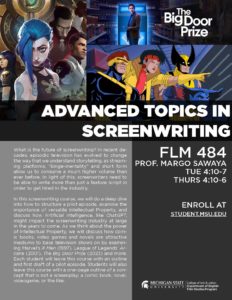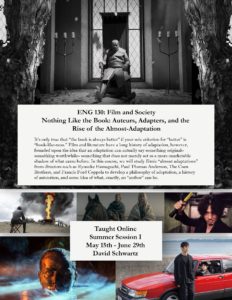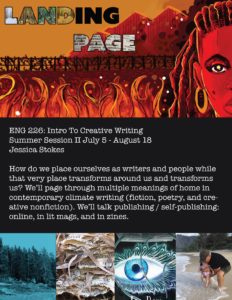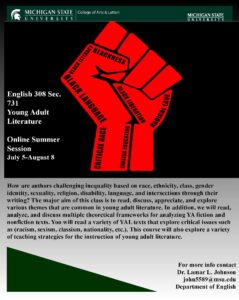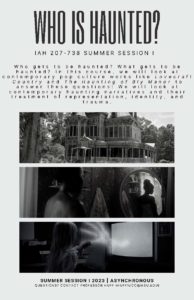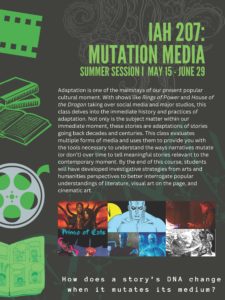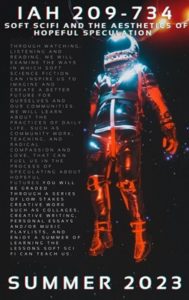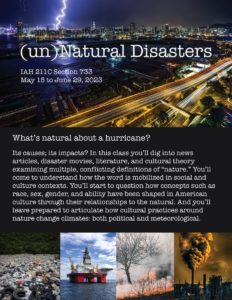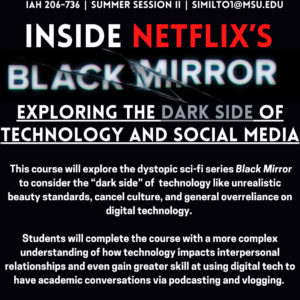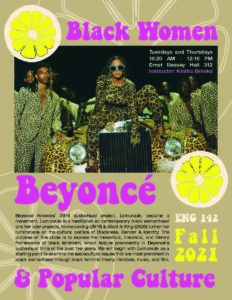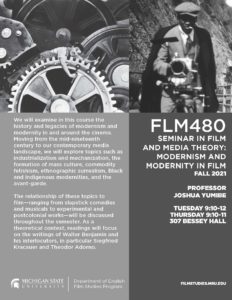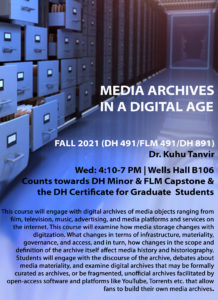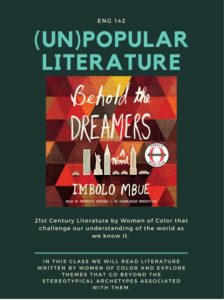Spring 2025 Course Descriptions
“Intro to Creative Writing” is a primer course, meant to give you a flavor of four distinct forms of creative writing: fiction, film, non-fiction, and poetry. For each form, we will:
· read craft lessons,
· do close readings of examples of the form (a novel, films, essays, poems),
· produce short works of our own
Thus, we will engage with each form at an (i) idea, (ii) example, and (iii) practice level.
Fall 2024 Course Descriptions
This course introduces students to literary studies through formal analysis of interesting and complex literary texts. Readings will span four genres: prose fiction (the short story), drama, poetry, and the essay. The reading load will be relatively light but students will be strongly encouraged to practice re-reading. Students will also be encouraged to attend on-campus events related to the genres we are studying. Assigned reading includes a dozen short stories by writers from around the world; poetry by two American writers (Emily Dickinson and Joy Harjo); two plays by the British playwright Tom Stoppard; and a collection of creative non-fiction essays by the U.S. writer Marcia Aldrich. Students will write informally on a regular basis, and will write two critical essays (both revised) of the sort required in many upper-division courses in the English Department.
In 2016, the Swedish Academy awarded the Nobel Prize in Literature to Bob Dylan for “having created new poetic expressions within the great American song tradition.” The decision pleased his fans but left others miffed, some irate. Bob Dylan, a songwriter, won the Nobel Prize in Literature? What then is literature? What is the object of study for a class like this one, an introduction to literary studies? For more than a century, one of the primary tools for distinguishing something called “literature” from mere entertainment has been––and this may explain the uproar over Dylan’s Nobel––the literary prize. In this course, we will trace the ever-shifting boundaries of literary culture by following the evolution of the Booker Prize, the MacArthur Fellows (“genius grant”) Program, the National Book Awards, the Nobel Prize in Literature, and the Pulitzer Prizes. Through the writing of T. S. Eliot (Nobel), Dominque Morrisseau (MacArthur), Toni Morrison (Pulitzer, Nobel), Aravind Adiga (Booker), and, yes, Bob Dylan (Nobel), we will consider the thorny politics of literary prestige––who defines it, who receives it, and whose interests it serves. In addition to interpretive writing, we will author our own nominations and invent prizes honoring the kind of literature that we most admire.
This course introduces students to the practice of writing creative nonfiction as an evolving genre of literature. The thematic and methodological focus for this course is “The Senses.” As such, students will undertake the embodied practices of observation, notation, recollection, cataloging, and re-enacting, while developing the critical skills of close-reading, literary analysis, researching, and proposing. Students will learn how to balance spontaneous and guided composition in a variety of minor genres in order to understand different modes of and approaches to creative nonfiction. Students will be introduced to a range of composition processes intended to stimulate frequent and adventurous writing, and will be encouraged to make disciplined and inventive use of the revision process. Through an experimental approach to writing, reading, and collaborative response, students will develop a compact portfolio in keeping with the realities of an asynchronous course during a global pandemic. Finally, they will grow as writers in a spontaneous community through a robust and empathetic approach to the peer-review process, in close consultation with their instructor.
We’ll look at the different methodologies literary theory offers and the histories that give shape to these approaches.
Historical conversations about the canon (the texts widely considered as important in a culture) often go through F.R. Leavis’ still controversial text The Great Tradition (1948), where it can be said that Jane Austen became a central part of the academic conversation about the English canon. Why make Jane Austen part of the canon and how is the canon changed by her presence? This course will begin with a number of debates about the canon and then we will turn to Austen to consider how she is read today. Later, we will focus on how Austen’s work frequently extends the boundaries of the traditional canon into popular culture. Jane Austen’s Pride and Prejudice (1813) and Persuasion (1817) will be part of our investigation, as will the anonymously written Regency novel A Woman of Color (1808) which focuses on a mixed-race heiress from the Caribbean who journeys to England to be married. This important work, republished in 2008, suggests how approaches to gender and race within the Regency novel propelled a more representative literary form. Austenesque popular culture in the course will include Shonda Rhymes’s recent adaptation of “Bridgerton”, which revisits and expands the flexibility of the Regency marriage plot to continue to suggest how these novels can establish a place for previously disempowered voices.
Institutions of American Literature
When we watch a movie, we know that a lot of people had a hand in making it. It’s right there in the credits: stunt coordinator, boom operator, man in elevator #3. When we read a book, we see one name: the author’s.
This course will consider whom and what else we should credit for the book in our hand. It will investigate the institutions through which the author and book travel en route to the reader: the creative writing program, the literary agency, the publishing house, the book club, the literary prize. How did the rise of the MFA program change American literature? How has the consolidation of New York publishing altered what we read? What about the Book-of-the-Month Club? Oprah’s Book Club? The Pulitzer Prizes?
The author––the boldfaced name on the cover––wrote the book, yes, but not by themselves and not under conditions of their own choosing. Through the writing of Mona Awad, Raymond Carver, Edwidge Danticat, Lisa Halliday, Cormac McCarthy, Lorrie Moore, and others, this course will fill in the missing credits.
This course introduces students to American poetry from the mid-nineteenth century to the present. It is designed for anyone wanting to deepen their knowledge of and appreciation for poetry. We will address basic questions about what poetry is for, why it is often “difficult,” and how it is a form of language-play that engages with fundamental questions about selfhood, society, and human existence. Given our focus on modern and contemporary American poetry, we will think about the relationship between poetry and the social and cultural history of the United States since the mid-19th century. Assigned texts will probably include Rita Dove (ed.), The Penguin Anthology of Twentieth Century American Poetry, and LeAnn Howe (ed.), When the Light of the World Was Subdued, Our Songs Came Through: A Norton Anthology of Native Nations Poetry, supplemented by poems from the website of the Poetry Foundation. Students will hone their interpretive skills through journaling, in-class writing, focused writing exercises, and small-group discussions. Instead of formal argumentative writing, students will create a personal archive of poems (organized by theme or topic or form) and write a critical introduction to it.
This course focusses on the origins, rise, and revision of the popular genre we call Weird Fiction, which is itself defined by its difficulty to categorize. Even as it draws on a variety of other genres, including myth, speculative science fiction, Gothic, and horror, the Weird eludes easy categorization and serves wildly different political ends. Our class will begin with the emergence of the Weird in the context of late nineteenth century decadence before moving on to its proliferation in the pulp magazines in the early twentieth century, particularly in relation to Lovecraftian “cosmic horror.” Finally, we’ll turn to contemporary writers of the New Weird to ask how the genre allows us to reframe urgent issues of gender, sexuality, race, and environmentalism.
This course will explore African American literature from the late 19th century to the present, focusing on speculative fiction and fantasy. While traditional surveys of African American literature tend to emphasize autobiography (e.g., slave narratives) and literary realism, there is also a rich tradition of imaginative and fantastical literature by Black writers. Our course will begin in the late 19th century, during a peak of interest in “Negro folklore” that would continue through the 1930s. We’ll examine original fiction, folk tales, and ethnographic writings on “conjure” and “hoodoo” (a set of African American folk beliefs and spiritual practices) by Charles W. Chesnutt and Zora Neale Hurston. Then we’ll turn to African American novels from the late 20th and 21st centuries that take up this legacy. We’ll study “neo-slave narratives” that use gothic devices like the ghost story (Toni Morrison’s Beloved) or mix alternate history with speculative technologies (Colson Whitehead’s The Underground Railroad). We’ll also examine postmodern fantasy (Samuel R. Delany’s Tales from Nevèrÿon) and Afrofuturist horror (Octavia Butler’s Fledgling). We will attend to the aesthetic qualities of the texts as well as the social and political issues raised by them. Some of the questions we’ll consider include: how do speculative or fantastical elements engage with conventional understandings of history and futurity? Why have traditional narratives of African American literature privileged ‘realistic’ literature over speculative fiction, science fiction, fantasy, and other popular genres? What happens when ‘literary’ writers take on ‘popular’ genres?
One of my specialties is East-West Comparative Studies, to which ENG360 on postcolonial and diaspora culture belongs. This course focuses on “Only CON-nect: East-West Con Game of Touching,” fulfilling Tier II writing requirement. What if E. M. Forster’s plea to reach out to the Other—“Only CON-nect!”—comes with a hyphen and a first-syllable accent that expose the exhortation as a con game unbeknownst even to the (con) artist? The touching stories of hemispheric, cross-cultural, transpacific, and transcontinental intercourse enthuse from con artists largely unaware of the overreach of romantic passion, subconsciously gaming their narratives with wish-fulfillment and magical thinking. Fingers outstretched toward the sun cast the shadow back on the body, or the other way around, out of the heart’s secret desires does the arm unfurl. Three sections on “Colonial, Comic, Caffeine” trace how East and West stumble to CON-nect. From the coloniality of Forster, Lu Xun, and Robert Van Gulik, the class moves to “comic relief” of Gene Luen Yang’s graphic novel and Wang Chen-ho’s Taiwan satire. The course concludes with a cup of magical, caffeinated tea from Asian North American novelists of Louis Chu and Judy I. Lin “tripping” back home, the mythical Orient. The course grade is based on papers, exams, and attendance and class performance.
“Victorian Nature Writing”: Do you like to read about plants? Do you like to be in nature and write about it? Take a course that will introduce you to how nineteenth-century writers in Britain and across the British empire represented plants and “nature,” in general, while inviting you to explore and write about several of the beautiful garden and forest sites on MSU’s campus. This course has two related objectives. First, it will guide you to develop a rigorous critical and historical perspective on Victorian culture, which continues to shape/haunt the present, by focusing on literary representations of plants and nature. We will discuss these literary representations in the context of key historical formations, such as the concept of evolution, the rise of natural history and its systems of classifications, empire and colonialism, race, domesticity, the gender binary, the public versus private spheres, industrialization, climate devastation, and urbanization. Possible works include poetry and fiction by John Clare, Mary Seacole, Charles Dickens, George Eliot, Olive Schreiner, Beatrix Potter, Isabella Bird, Thomas Hardy, H. G. Wells, and Mary Kingsley. Second, the course will offer experiential learning, providing you the time and opportunity to be in “nature” and to think and write creatively toward, about, within, around, and to it. We will take field trips during class time to the Beal Botanical Garden and other sites on campus, including possibly the Baker Woodlot & Rejandra Neotropical Migrant Bird Sanctuary, the Japanese Garden, and the Native Gardens at the Kellogg Bird Sanctuary. By studying Victorian nature writing and writing your own, you will have the opportunity to explore and create ethical and positive ways of representing your relation to the plant world and nature in general.
The Advanced Fiction workshop will focus exclusively on the long form of genre fiction. Each student-writer will submit 35-50 pages of fiction in a genre of their choice and receive feedback from their peers and professor. Interest in genre fiction, experience with a fiction workshop, and active engagement in workshop feedback are essential. We will also read a novel and analyze it, through the lens of craft, for skills that we as writers can glean and include in our own writer’s toolkit.
One of the most rigorous practices of contemporary theater-making, documentary theater is created from interviews, transcripts, archives, and living research. It is a civically minded practice that converses with contemporary events, and engages the theater as a space for dissection and discussion. With texts authored by Anna Deavere Smith, Tina Satter, Lucas Hnath, Moisés Kaufman and many others, we will analyze the dramatic tools that shape the texture of a community or a given moment in our shared history with a particular focus on gender. Through a variety of plays and secondary sources, with a spirit of social justice and activism, we will read these plays, write about these plays, and maybe even create our own documentary theater texts.
This course seeks to develop skills in perception, comprehension, and interpretation when dealing with film and other moving image media. It encourages the close analysis of audiovisual forms, their materials and formal attributes, and explores the range of questions and methods appropriate to the explication of a given film or moving image text. It also examines the intellectual structures basic to the systematic study and understanding of moving images. Most importantly, the course aims to foster in students the ability to translate this understanding into verbal expression, both oral and written. Texts and films are drawn from the history of narrative, experimental, animated, and documentary or nonfiction cinema.
This course on Asian cinema covers Japanese auteur and anime, Chinese Fifth- and Sixth-Generation, New Taiwan Cinema, the Korean Wave, Asian Horror, action and kung fu thrillers, Asian American box office hits and indies, Hollywood remakes, and TV series. Some weeks are structured along national lines, others along generic distinctions or thematic interest. In addition to analyzing films as art and cultural products, we also draw from film theory and cultural studies readings. Filmmakers to be discussed include Ozu, Kurosawa, Oshii, Zhang Yimou, Jia Zhangke, Edward Yang, Ang Lee, Hou Hsiao-hsien, Jon M. Chu, Alice Wu, Su Lun, and Park Chan-wook. Grading is based on papers, exams, and class participation.
This course will present a critical survey of the principal authors, concepts, movements, and films in the classical period of film theory from roughly 1915 to 1960. Weekly readings and discussion will examine major film movements and technological developments of the period—for example, Soviet montage and the advent of the sound film—as well as the work of major figures such as Sergei Eisenstein, Dziga Vertov, Esfir Shub, Hugo Münsterberg, Rudolf Arnheim, Stefania Zahorska, Jean Epstein, Riciotto Canudo, Germaine Dulac, Béla Balázs, Erwin Panofsky, Hans Richter, Siegfried Kracauer, Walter Benjamin, and André Bazin. Although the main emphasis will be the work of theorist-practitioners writing in the context of French, German, and Soviet cinemas, the course will de-center this continental approach to include, for example, theoretical assessments of Hollywood’s industrial mode of film production as well as early film critics of the Global South whose work may be better understood today as film theory. Our study of the aesthetic and political debates surrounding the emergent medium will be animated by the following questions: What is cinema? What can cinema do? What is cinema’s social function? Is cinema an art? If so, how is cinema different from other art forms? What will cinema become?
Summer 2024 Course Descriptions
Have you ever been so frightened that you burst out laughing? Have you ever laughed until you cried? This online summer course looks at two popular film genres and their intersection: horror, comedy, and horror-comedy. As a genre, horror is often said to represent our collective fears. Yet humor, too, can be thought of as a way of managing anxiety. Both fear and laughter, after all, produce endorphins that we associate with pleasurable thrills and release. This course will function as an introduction to the genre of horror and the social fears it indexes, including ‘deviant’ sexualities, primitive religions, toxic masculinity, xenophobia, the sociopathy of capitalism, and more. Students will learn basic elements of film analysis and examine films in their social and historical contexts. We will pay special attention to the development of “horror-comedy,” from the unintentional humor of classic Hollywood monster movies, to campy exploitation films of the 1960s and 70s, to the biting satire of contemporary films like Get Out. Week-long units will focus on subgenres like slasher films, captivity narratives, possession, vampires, and zombies.
Spring 2024 Course Descriptions
What is literature? What do literary works tell us about what it means to be human? What do they tell us about the nature of human agency and its scope within social, political, and economic structures? And how do literary works do all of these things? Literary theory helps us think about these questions by putting pressure on what we take for granted about literature and, by extension, how we individually and collective define the meaning of life. Theory is simply the effort to make sense of what is presented to us as common sense, and thus as self-evident, inevitable, and universal. Theory teaches us that common-sense ideas about literature and life are also “just” theories that have come to be taken as truths. In this way, theory has the capacity to point to alternative, potentially emancipatory ways of thinking. This course introduces students to some of the major movements in literary criticism and theory. We will read a select few literary texts and consider them in light of different theoretical questions and approaches, including feminist, Marxist, postcolonial, queer, and disability literary studies, ecocriticism, and Black studies.
What is literature? What do we gain from reading it, or studying it? How should we study it? How is literature related to culture—for example, to identity, power, politics, or social values? Literary theories attempt to answer these questions, and others like them. To that end, this course will introduce you to a range of theories that offer different answers to such questions—answers that may be overlapping, conflicting, or difficult to ascertain. We will scrutinize several theories of language, authorship, representation, and identity. We will also use what we learn to discover, through the practice of writing, the pleasures and difficulties of literary analysis. What is a “text” or an “author”? What do literary texts do? How do readers create meaning, rather than merely ‘find’ it? What purposes do different types of interpretation serve? Questions like these will guide our discussions.
The high seas denote the open waters beyond national territorial boundaries, which is where the literary and filmic texts in this course lie, unmoored between the East and the West. The pun on high Cs invokes the soaring, emotionally intense vocal registers reached by preeminent tenors and sopranos. The interstitial, amorphous, and pregnant space between the two hemispheres coincides with the affective climax in classics, colonial encounters, and caffeinated trips. Hence, this introduction to literary studies surveys global culture from the exhilarating “Dark Ages” to the imaginary YA stimulants. Five weeks are devoted to Anglophone classic epic Beowulf and Sinophone chapter novel Monkey, complemented by film adaptations. The subsequent five weeks focus on colonial (dis)connections in turn-of-the-last-century E. M. Forster’s A Passage to India and Lu Xun’s short stories, animated by David Lean. The last five weeks perk up with a cup of magical, caffeinated tea from Asian North American novelists of Louis Chu and Judy I. Lin “tripping” back home, the mythical Orient, while we nibble on Domee Shi’s Bao and Toronto Chinatown bilingual signage. High Cs steep into Lin’s High Tea Exotica, its young adult (and adult?) fans getting high by getting dis-oriented. The course grade is based on short papers and class performance.
In 2016, the Swedish Academy awarded the Nobel Prize in Literature to Bob Dylan for “having created new poetic expressions within the great American song tradition.” The decision pleased his fans but left others miffed, some irate. Bob Dylan, a songwriter, won the Nobel Prize in Literature? What then is literature? What is the object of study for a class like this one, an introduction to literary studies?
For more than a century, one of the primary tools for distinguishing something called “literature” from mere entertainment has been––and this may explain the furor over Dylan’s Nobel––the literary prize. In this course, we will trace the ever-shifting boundaries of literary culture by following the evolution of the Booker Prize, the MacArthur Fellows (“genius grant”) Program, the National Book Awards, the Nobel Prize in Literature, and the Pulitzer Prizes. Through the writing of T. S. Eliot (Nobel), Dominque Morrisseau (MacArthur), Toni Morrison (Pulitzer, Nobel), Aravind Adiga (Booker), and, yes, Bob Dylan (Nobel), we will consider the thorny politics of literary prestige––who defines it, who receives it, and whose interests it serves. In addition to interpretive writing, we will author our own nominations and invent prizes honoring the kind of literature that we most admire.
What is literature? What do we gain from reading it, or studying it? How should we study it? How is literature related to culture—for example, to identity, power, politics, or social values? Literary theories attempt to answer these questions, and others like them. To that end, this course will introduce you to a range of theories that offer different answers to such questions—answers that may be overlapping, conflicting, or difficult to ascertain. We will scrutinize several theories of language, authorship, representation, and identity. We will also use what we learn to discover, through the practice of writing, the pleasures and difficulties of literary analysis. What is a “text” or an “author”? What do literary texts do? How do readers create meaning, rather than merely ‘find’ it? What purposes do different types of interpretation serve? Questions like these will guide our discussions.
In English 308, we read, discuss, appreciate/critique, and respond to a wide range of literary texts written for and marketed to youth. As readers, we explore diverse genres, characterization, imagery, point of view, tone, and other literary dimensions of young adult literature (YAL). As well, we explore the diverse impacts of these literary dimensions on us as readers. We (re)examine taken-for-granted assumptions about adolescents/ce and consider how our interpretations of YAL can inform our potential future work with youth. In this course, you can expect to
• develop and apply criteria for evaluating young adult literature and selecting books for youth,
• engage scholarly resources to develop your interpretations of literary texts, and
• create diverse literary responses to start conversations and share your interpretations of young adult literature with book club groups.
Throughout the semester, we will pay particular attention to the ways young adult literature represents (or not) the lives and experiences of diverse children and youth, including those from historically marginalized populations.
For over 400 years, readers and play-goers have been entranced by the language, imagery, themes, narratives, and sometime emotional roller-coasters of Shakespeare’s works. As I hope you find in this course, Shakespeare’s writings have much to say not only about his own culture but also about our own. Moreover, the richness of his texts offers an abundance of potential for various critical approaches. We begin this course with political, religious, and social background on Shakespeare’s England, including the material conditions of textual and theatrical production. By doing so, I hope to be able to provide a foundation for understanding how “Shakespeare” as we know the phenomenon emerged from a particular situation within history and the history of literature. We then proceed to seven plays chosen across Shakespeare’s career and across genres (comedy, tragedy, tragicomedy, history and romance)—Titus Andronicus, Richard II, The Merchant of Venice, Twelfth Night, Measure for Measure, Othello, and The Tempest—as well as a brief stint in the middle of the semester on Shakespeare’s sonnets. We will approach the plays and poems from a variety of perspectives such as anthropological, post-colonial, historiographic, economic, and socio-political, as well as those that apply early modern theories of genre, gender, sexuality and race. Much of our class discussions will focus on close reading particular passages from the texts, though we will also explore performances of the plays through film clips. Our textual analysis in class should help students in preparing two 5-6 page critical essays, which should perform close readings of a work within a clearly structured argument. In addition to the essays, there will be a midterm, a final exam, and several unannounced quizzes throughout the term.
The course will look at the ostensible divisions in philosophies behind the purpose of higher education: is it to prepare students for living full and socially responsible lives or for making a living? This perceived binary lies at the heart of the land grant tradition, calls into question the place of the humanities, and establishes the long arc of the culture wars that perennially dog the public’s view of the “good” of higher education.
This course will explore comics culture in the United States through the critical investigation of Superhero Comics (SC), Afrofuturist Comics (GM), and global comics narrative as expressed through the MSU Library’s Comic Art Collection (CAC). Superhero comics have shaped popular culture, reflecting shifting concerns about identity, community, and power. Afrofuturist comics are graphic narratives that manifest discourses about speculation and liberation central to Afrofuturist ideology. Our final consideration is to take advantage of the 300,000+ comics and comics artifacts housed within the MSU library. We will use Wikidata to explore information about comic creators and publications outside the United States. We will learn about and then apply three methods of critical engagement to study these graphic narratives: close reading, critical making, and digital humanities. We will write about visual narratives, make comics, and then create digital visualizations of the archives to reveal new pathways to understanding comics. This course will culminate in a project where students present their comics in a public showcase on campus (with an online companion element). The overall goal is first to learn about comics content, demonstrate engagement with writing and making them, and then gain valuable experience using digital methodology to examine comic culture.
Readings in Novel and Narrative: Climate Fiction (Cli-Fi) in the Time of the Anthropocene: The urgency of climate change is obvious to all, and no one can ignore either the mountains of mathematical data or the “facts on the ground” of floods, droughts, fires, hurricanes, deadly temperature spikes, and global pandemics. Also exponentially growing is the literary response to these catastrophes, and this course will help us to locate ourselves mythically, poetically, and philosophically in our new world and to reimagine who we are, how we got here, and where we might be going. What choices do we have, and how might we act in the time that remains?
This course offers a broad survey of the cultural phenomenon of steampunk, that retrofuturistic genre of speculative fiction that takes thematic and aesthetic cues from the Victorian age. Beginning with examples of the Victorians’ own technological fantasies (what we can from our perspective call “steampunk prime”), we’ll investigate the rise of the genre in the late 20th century and its proliferation into a broad and increasingly diverse range of texts. The subjects we’ll discuss will include short stories, novels, comics, and film, all of which will ask us to think through our relationship with technology and our complicated historical inheritance. But they will also offer fresh ways to reframe pressing issues of racism, postcolonialism, and gender.
This course will explore African American literature from the late 19th century to the present, focusing on speculative fiction and fantasy. While traditional surveys of African American literature tend to emphasize autobiography (e.g., slave narratives) and literary realism, there is also a rich tradition of imaginative and fantastical literature by Black writers. Our course will begin in the late 19th century, during a peak of interest in “Negro folklore” that would continue through the 1930s. We’ll examine original fiction, folk tales, and ethnographic writings on “conjure” and “hoodoo” (a set of African American folk beliefs and spiritual practices) from this period. Then we’ll turn to the African American novel, focusing on the late 20th and 21st centuries. We’ll read “neo-slave narratives” that use gothic devices like the ghost story (Toni Morrison’s “Beloved”) or mix alternate history with speculative technologies (Colson Whitehead’s “The Underground Railroad”). We’ll also look at Black fantasy (Samuel R. Delany’s “Tales from Nevèrÿon”) and Black horror (Octavia Butler’s “Fledgling”). Other concepts we’ll learn about include postmodern aesthetics, Afrofuturism, and magical realism. Our readings will be supplemented by critical essays and poetry.
The course introduces you to US Latinx literatures and the social and historical contexts that inform their production. We will emphasize close reading of primary texts, and materials will include poetry, essays, drama, film and fiction, as well as representations of Latinx people in United States popular culture. While foregrounding the distinct character of Latinx art and literature, the course should also continuously challenge broader assumptions and expectations regarding Latinx people in America. The creative work we engage with will teach readers much about the culture and history of Chicanx and US Latinx people, but our goal is also to interpret literary texts as works of art, crafted artefacts that explore multiple levels of meaning and that exist in the broader history of “American literature.”
ToThis course examines the development of Afro-Brazilian literary production and criticism, underlining Black Brazilian identities as represented through the African Diasporic experience. Using a decolonial perspective, we will explore the work of Black intellectuals, artists, and activists who have laid the groundwork for the creation of an Afro-Brazilian literary canon. We will investigate the complex intersections between race, class, and gender issues in Afro-Brazilian literary and cultural production of the 20th and 21st century.ggle Content
The focus of SS24 ENG 362 001 (asynchronous) will be on the Modern/Contemporary Literature of The United Kingdom, a crucial body of poetry, fiction, drama and film, from Thomas Hardy to Fleur Adcock, from Joseph Conrad, DH Lawrence and Virginia Woolf to Andrea Levy and Kazuo Ishiguro, from GB Shaw to Harold Pinter. The UK significantly affected the formation of the modern world, and certainly inaugurated the character of what we think of as English literature and language. It is now publicly multicultural and within the orbit of global popular culture, yet somehow ‘Britain’ also keeps itself away from the world, not quite like anywhere else. This adjacent combination of insularity and globality is full of true and false analogies (both interesting and useful) for Americans.
William A Johnsen is Professor of English whose research focuses on modern European writers and theorists. He has led 27 study abroad programs to England and Ireland (once to Italy)
Is every story a love story? Is every love story really about love? In this course, we will look at fiction that consciously engages with ideas of romance and love, contemplating the ways in which fiction writers use romance to advance plot, center emotion, challenge norms, and raise expectations. What kinds of love count as achievement? Adventure? Self-actualization? And to what degree do narratives that subvert old romantic models still rely on them? Writers for the semester include Andrew Sean Greer, Samantha Allen, Christopher Gonzalez, E.J. Levy, Curtis Sittenfeld, and S.J. Sindu, and we will also turn to our own fiction to consider how we write, resist, and complicate love on the page.
This course explores community and world-building in education generally and English language arts specifically. This exploration will take place through encountering three “activist” or liberatory traditions across the semester: visionary, speculative, and participatory. The course will explore how educators, organizers, and artists work toward freedom and liberation through these traditions. In this exploration we will encounter 1) writing across various genres (e.g., fiction, poetry, essays, archived conversations), 2) curricula designed with these traditions in mind, 3) and protocols for facilitating the kinds of interactions among students/people that come from these traditions.
Instructor: Emery Petchauer
This capstone seminar explores the relationship among sound, aurality, composition, rhetoric, and pedagogy. This exploration will take place through readings, listenings, and regular opportunities to create with sound. Reading: How sound and sonic phenomenon are considered by scholars ranging from literary theory to writing and rhetoric. Listening: How political sound artists, electronic and hip-hop music producers, and beyond use the vibrations of sound in their aural compositions. Creating: Regularly composing, writing, and making with sound and sound making technologies over the course of the semester. (No prior experience necessary.)
Dario Fo & Franca Rame: Marxists, Feminists, Stage Jesters
Dario Fo won the Nobel prize for literature in 1997 inspiring gasps, sneers and applause around the world. He and Franca Rame, his partner in life and art for almost 60 years (who many believe should have been jointly awarded the Nobel) had the distinction of being the most performed living playwrights across the globe during more than three decades of their lives. They were known for their fearless political satire, but was their theater an artistic practice that questioned contemporary politics, societies, and structural bias, or was it a method of political protest? We will walk the line of art and activism with Fo and Rame, investigating the extent to which theater itself can be a site of discourse, dissent, and, of course, play.
Instructor: Divya Victor
The fundamental goal of this course is to help you develop effective, sustainable, and socially meaningful practices for writing through the genre of poetry. You will develop a broader and deeper understanding of poetry as a literary form and artistic practice. You will become familiar with a broad range of poetic practices and use these as launch pads for improvising and developing a critical understanding of poetry as an expressive form of political and cultural engagement. You will explore new compositional methods through experimentation, peer-to-peer conversations & critique, and collaboration. Through collaboration with your fellow writers, you will find new ways of participating in writing communities, forming kinships with a range of innovative arts and cultural practitioners. Along with studying craft, you will also analyze the concepts of audience, medium, and performance as foundational considerations for your own compositional methods. Through an experimental approach to writing, reading, and collaborative response, students will develop a compact portfolio. Finally, you will grow as writers in a spontaneous community through a robust and empathetic approach to the peer-review process, in close consultation with your instructor.
This course is a seminar focusing on the literature of early America, 1492 – 1820. Counterintuitively, we will begin the course by reading a short contemporary novel: Toni Morrison’s A Mercy (2008). The themes of that novel will frame the semester’s reading: settlement and unsettlement, conquest and dispossession, slavery, religion and law, nature vs culture, immigration and identity, gender and sexuality. This course will ask students to broaden their conception of “literature” because (after beginning with a novel) our reading will focus on slave narratives, sermons, political treatises, travel narratives, scientific treatises, poetry, and satire. The Broadview Anthology of (Early) American literature will be our main text because it surveys the incredible diversity of voices in the period. This course uses “ungrading” (non-traditional) assessment methods focused on feedback (not grades) aligned with the course learning goals.
How does literature represent the mind? What effect does reading literature have on thought and emotion? This course takes up these questions in a period where debates about cognition had become newly vibrant: the Enlightenment. Reading a range of literary and scientific works engaged with theories of the mind and brain— eighteenth-century treatises on emotion, anatomical engravings, best-selling novels and essays, satires on science, poetry, and works of pornography—we explore the history of rationality and its discontents, objectivity and memory, and depictions of cognitive control lost (absorption, obsession, and madness). As we discuss the history of curiosity, boredom, distraction, happiness, and desire, we will also consider the distinctly historical ways that eighteenth-century literature raced, gendered, classed, and sexed the body and mind. Students will learn to use databases like Eighteenth-Century Collections Online and Metaphors of Mind to explore literature’s connections with the history of science, engage interdisciplinary scholarship on theories of the mind, brain, and environment, and discuss new work in cognitive literary studies and the history of neuroscience. Students will be asked to participate actively and creatively in discussion, keep abreast of our reading schedule, and conduct a final research project on a topic of personal interest in the literary history of cognition.
This course is about the intersection of two fields that are not usually or automatically connected with one another the literary and the medical. As you will see this semester, there is a complex tradition of relations between these two areas concerning the language of medicine, the experience of illness, serious and popular narratives, medical humanities, historical and cultural approaches to the experience of illness and disease, death and dying, wellness, being and identity. One special aspect of this course is that in part
we will approach the situation we find ourselves in recent times: the pandemic. We will approach this through Albert Camus’ The Plague and some short readings from Frank M. Snowden’s Epidemics and Society patient narratives.
This course guides students through an intensive research project, from start to finish. For undergraduate students, it is a capstone course that represents a summative experience, gathering together the primary skills developed in the English major (close reading, engagement with secondary sources and literary theory, interpretation within historical contexts, structuring an essay and developing a thesis, etc.). For graduate students, it is a post-1800 course that further develops critical, research, analytic, writing, and communication skills. For both stages of students, this course introduces some of the major critical problems in the field of Victorian literary and cultural studies. In this course, you will pursue sustained research on a specific critical problem in the interdisciplinary field of Victorian Studies. I will lay out a range of current critical problems that are engaging Victorianist scholars at the moment, such as the relation of literature to the historical formations of empire, race, gender, disability, and climate devastation, and the intersections among two or more of these. With my support, you will pick a critical problem of interest to you and decide on what kind of culminating experience you wish to work toward. The culminating experience may be a thesis or article-like essay of 15 – 20 pages, which could serve, for undergraduate students, as a writing sample for graduate school and, for current graduate students, as the basis of an article. You may also propose an alternative idea, as long as it involves the skills mentioned earlier. The course will be conducted like a workshop with frequent short presentations and the semester will conclude with a mini-conference in class. I will provide PDF’s and links to all required reading.
This course will provide a scaffold for students to draft and revise a “longform” independent writing project, such as a collection of poems, an essay collection, a book-length memoir, or a novel. Students will receive peer and faculty support to nurture their writing and develop the habits and practices that can sustain their writing lives beyond MSU. ENG484E fulfills the capstone requirement for students in the Creative Writing Program. Possible texts include Virginia Woolf’s A Room of One’s Own, Jessica Abel’s Growing Gills, and Matt Bell’s Refuse to Be Done
How do art, culture, and literature respond to times of massive social and economic upheaval? We’ll pursue the complicated and surprising answers to that question by studying the greatest period of global transformation in recorded history, the Industrial Revolution, which we’ll examine through the works of writers in Britain, the first culture to experience its profound effects. We’ll consider not only the rise of transformative technologies and new patterns of social life, but also the ways Industrialization unsettled fundamental assumptions about the virtue of work, the nature of gender, and the experience of time and space. We’ll explore the emerging world of powerful capitalists, ambitious reformers, and angry radicals through the eyes of Victorian writers whose work combined a fierce moral optimism with a deep fear that the world had become crueler and more alienated than ever before.
This course introduces core concepts of film analysis, which are discussed through examples from different national cinemas, genres, and directorial œuvres. The coursework covers a wide range of styles and historical periods in order to assess the multitude of possible film techniques (camera techniques, editing, shot selection, etc.) and principles of narrative structuring. Along with questions of film technique and style, we consider the notion of the cinema as an institution that comprises an industrial system of production, social and aesthetic norms and codes, and particular modes of reception. Success in the course demands rigorous attention to both the films and the readings and requires students to watch, analyze, and write about film in new ways. Throughout the semester, students will learn different methods of viewing, analysis, exposition, and criticism and will have the opportunity to write extensively about the films seen in class. Films discussed include works by Brakhage, Burnett, Deren, Griffith, Eisenstein, Hitchcock, McQueen, Sternberg, Varda, and Welles.
Examining the films of Stanley Kubrick, thinking about Kubrick alongside the cluster of film geniuses around him; looking at contemporaries to whom he is often compared.
Instructor: Joshua Yumibe
This course surveys the history of cinema from the middle of the twentieth century to the present. Moving chronologically, we will track a variety of national schools and international trends of filmmaking in order to analyze the global development of film exhibition practices, production cycles and trends, and the changing landscape of distribution. We will examine the formal, industrial, and cultural changes of the medium from neorealism and film noir to blockbuster franchise cinema. Putting Hollywood in dialogue with its various “others,” we will engage a variety of national and international film movements: global new waves, auteur and art cinemas, Third Cinema, experimental film, exploitation cinema, contemporary “slow cinema,” and more. We will also discuss key moments in the transformations of Hollywood since 1948: its postwar boom, the blacklist, the decline of the studio system, the rise of independent production, the demise of the production code, the New Hollywood of the 1970s, and the film industry’s gradual conglomeration. The course’s final weeks will be devoted to exploring the so-called “death” of film in the digital domain, from the rise of computer animation and digital 3-D to revolutionary changes in the distribution and consumption of cinema. This broad and comparative approach to the history of cinema will engage with a variety of primary and secondary textual sources in order to assess and cultivate theoretical methods for researching and writing film history.
Students will combine cinematography theory with hands-on practice as they take what they see in movies and translate to their own projects. Students will study differences in camera sensors, lenses, filters, lighting styles, camera movement, framing, and how these differences help to tell the story.
This course on Asian cinema covers Japanese auteur and anime, Chinese Fifth- and Sixth-Generation, New Taiwan Cinema, the Korean Wave, Asian Horror, action and kung fu thrillers, Asian American box office hits and indies, Hollywood remakes, and TV series. Some weeks are structured along national lines, others along generic distinctions or thematic interest. In addition to analyzing films as art and cultural products, we also draw from film theory and cultural studies readings. Filmmakers to be discussed include Ozu, Kurosawa, Oshii, Zhang Yimou, Jia Zhangke, Edward Yang, Ang Lee, Hou Hsiao-hsien, Jon M. Chu, Alice Wu, Su Lun, and Park Chan-wook. Grading is based on papers, exams, and class participation.
The course will survey a style of filmmaking facilitated by the advent of lightweight and portable film equipment, which allowed for a more mobile, intimate, and (arguably) uncontrolled cinematography. Over time, the style became closely tied to the documentary genre, experimental film, and ethnographic filmmaking. Much like in the case of other regional cinemas of the global South, observational cinema adopted an extractive orientation to its Latin American subjects as Western filmmakers looked for an essential, unmediated truth about its subjects, often reinforcing existing imperialist, anti-indigenous, and anti-Black discourses. This class seeks to trouble the development of this type of filmmaking by placing the cinematic traditions of the North Atlantic (cinéma vérité, direct cinema, free cinema, etc.) with its lesser-known Latin American counterparts to rekindle an aesthetic and political dialogue to which Latin American and Latinx participation was always crucial. The class will adopt an intentional approach to its selection of films to survey a broad array of periods and artists. It will feature ethnographic filmmaking in Latin America made by foreigners; travel documentaries; early Latin American experiments in small gauge formats; U.S.-based underground cinema made by or featuring Latinx talent; state-sponsored educational film; radical and/or revolutionary cinema; community media; feminist, Chicanx, Latinx, and Afro-diasporic video work; as well as observational media forms in contemporary digital culture. The goal of the class will be to test the limits of observational cinema as a global style, to excavate a Latin American and Latinx agency in the development of this mode, to broaden its scope beyond mere ethnography, and to remind ourselves to always ask who gets to observe and who gets observed.
Toggle Conte
In 1926, the German playwright Bertolt Brecht thought he’d glimpsed the future of theater: “15,000 men and women of every variety of class and physiognomy” gathered to watch not a play by Shakespeare or Ibsen but a football match. If theater had any hope of surviving, he thought, it would need to incorporate the fun and spirit of athletic competition. Speaking for his fellow artists, he wrote, “We pin our hopes to the sporting public.”
Modern theater may not have turned out the way Brecht had wished––he long advocated for the introduction of a “smokers’ theatre,” where patrons could puff on cigars as if taking in a boxing match––but he anticipated the triumph of spectator sports. In 2022, athletic events accounted for 94 of the 100 most watched TV broadcasts. Most children in the United States participate in at least one sport, and a quarter will play into adulthood. This course will ask what this public, the sporting public, desires. What kinds of identities and communities do we form through sports? How might sports satisfy our deepest needs, offering us, in the words of the Trinidadian historian C. L. R. James, something not to live on but to “live by”? Through memoirs by William Finnegan and MSU alum Jemele Hill, the poetry of Ross Gay, and the fiction of Chad Harbach, we will consider sports through art and sports as art, and we will discuss where, amid a storm of legislation targeting trans youth athletes, we should pin our hopes.
nt
Fall 2023 Course Descriptions
Instructor: Juliet Guzzetta
Topic: “Thinking Against Literature”
English 210 is a “gateway” course to the English major that will introduce you to the habits, skills, and critical terminology of English as an academic field and give you a venue in which to practice and hone them. Many of these skills also translate into the critical skills of thinking and analysis that serve as a basis for your ability to read, interpret, experience, and change the world around you. In our section, we will center our discussions around how the works we read “think against” societal norms, and we will also “think against” what we might consider educational norms. This course is both reading and writing intensive and will engage different forms from different historical periods and places of the three main literary genres: poetry, prose, and drama. We will also use our literary skills in a “reading” of two films.
Instructor: Divya Victor
This course introduces students to the practice of writing creative nonfiction as an evolving genre of literature. The thematic and methodological focus for this course is “The Senses.” As such, students will undertake the embodied practices of observation, notation, recollection, cataloging, and re-enacting, while developing the critical skills of close-reading, literary analysis, researching, and proposing. Students will learn how to balance spontaneous and guided composition in a variety of minor genres in order to understand different modes of and approaches to creative nonfiction. Students will be introduced to a range of composition processes intended to stimulate frequent and adventurous writing, and will be encouraged to make disciplined and inventive use of the revision process. Through an experimental approach to writing, reading, and collaborative response, students will develop a compact portfolio. Finally, they will grow as writers in a spontaneous community through a robust and empathetic approach to the peer-review process, in close consultation with their instructor.
Instructor: Juliet Guzzetta
Learning to write plays concerns our ability to observe and interpret the relationships around us. At its core, playwriting distills human connections in words, words that are meant to be spoken out loud, in present time, in front of others, and shared. While we will read and analyze scripts from playwrights working today, the focus of this class will be on your art as you write and revise plays throughout the semester. Class consists of discussion, readings, writing exercises, and critique. You can expect to read some of the most-produced working playwrights today; develop your own unique voice; improve your skills as a writer of dialogue, plot, characters, setting, and more; author three revised plays; hone your ability to both give and receive constructive criticism; and cultivate your aural sensibilities in broad ways.
Instructor: Joseph Darda
Topic: “The Campus Novel”
This class will reintroduce you to something we all know well: college. Since the GI Bill of 1944 and the Higher Education Act of 1965, more and more Americans have––using their GI benefits or taking out federal loans––enrolled in college. Some have become novelists and, following the oldest advice around, written what they know. And what they know is college. In this course, we will visit the fictional campuses of, among others, Mary McCarthy, John Williams, Zadie Smith, and Susan Choi and watch the films Animal House and Dear White People as well as the Netflix series The Chair. We will consider what the campuses we imagine have to do with the campuses we inhabit and what a recent proliferation of campus novels might tell us about the state of higher education and the future of American literature. In addition to critical writing, we will produce our own campus fiction––set, perhaps, at a certain public university in central Michigan.
Instructor: Sheng-mei Ma
One of my specialties is Asian Diaspora Culture, to which ENG352 Asian American Lit and Film belongs. This course fulfills the diversity requirement. The other kinds of Asian Diaspora Culture include Asian Canadian, Asian Australian, and Anglo-Asian. We will study some prominent texts, such as Amy Tan’s The Joy Luck Club and Wayne Wang’s film adaptation, as well as Kevin Kwan’s Crazy Rich Asian and Jon M. Chu’s adaptation. We will also explore lesser-known ethnic classics, such as Louis Chu’ Eat a Bowl of Tea, Milton Murayama’s All I Asking for Is My Body, and Richard E. Kim’s Lost Names. The course will go beyond the US and study, for instance, the Chinese Canadian filmmaker Domee Shi. The course grade comprises papers, exams, and class performance.
Instructor: Bradley Deane
Topic: “Victorian Fiction and the Invention of Popular Culture”
Many of our familiar genres of popular culture — including detective stories, adventure novels, psychological ghost stories, and tales of invasions by monsters or aliens – emerged in something like their modern form in the late nineteenth century. This course surveys the explosion of new styles of popular literature during the final decades of Victoria’s reign, particularly in relation to the movement called the “romance revival,” when those popular genres were measured against the orthodoxies of realism in a heated debate over the artistry of fiction. But we will also consider the politics behind the very notion of popular culture as it emerged in this period, and the ways that these new genres intervened in contemporary controversies about gender, sexuality, crime, and imperialism.
Instructor: Robin Silbergleid
This course provides directed study of the forms of creative nonfiction at the advanced level. Our particular focus this semester will be on personal nonfiction, including flash nonfiction, memoir, personal essay, and auto-theory/personal literary & cultural criticism. We will also explore more broadly the various problems and issues that come up in the writing of literary nonfiction, including memory, voice and point of view, using and incorporating primary and secondary sources, the relationship between fiction and nonfiction, and the ethics involved in representing others. Along the way, we will be building habits toward sustainable writing practices, including daily writing, keeping notebooks, and metacognition/self-reflective documents. Possible texts include Ross Gay’s The Book of Delights, Sonya Huber’s Supremely Tiny Acts: The Memoir of a Day, Amy Krouse Rosenthal’s Encyclopedia of an Ordinary Life, and Jill Christman’s If This Were Fiction.
Instructor: Bradley Deane
Topic: “Race, Gender, and the Imperial Imagination: The British Novel in the Nineteenth Century”
How does literature inspire, perpetuate, or challenge global systems of power? This course will examine the rise of the novel in the nineteenth century alongside the vast expansion of the British empire, paying particular attention to the ways in which novels mobilized intersecting constructions of gender and race to reimagine identities in a world of imperial networks and colonial resistance. Considering a range of historical and geographical case studies (including slavery in the Caribbean, nationalist rebellion in India, and militarism in South Africa) we will examine shifting and competing cultures of empire from the perspectives of imperial jingoists and anti-colonial revolutionaries.
Instructor: Kate Birdsall
Topic: “Creative Writing Capstone / Red Cedar Review”
In this course, we will interrogate the relationship between creative writing, editorial theory, and publishing practice. You’ll participate in the production of Red Cedar Review, the literary magazine produced by undergraduates in MSU’s Department of English since 1963. We will also investigate, both theoretically and practically, how editors, publishers, and readers help to shape literary culture.
Instructor: Ellen McCallum
This section of ENG484 will focus on poet’s novels (e.g., Ocean Vuong, Anne Carson, Renee Gladman) to think about questions of genre, form, and critical practice. The course will combine aspects of the seminar and the workshop. We’ll spend the first four weeks reading & discussing the novels before then working through structured research steps towards a project on one or more of these works. The majority of the semester will be oriented towards polishing research skills like honing your research question, finding critical and contextual sources, developing an annotated bibliography, presenting your ideas.
Instructor: Joseph Darda
Topic: “The Public Humanities”
What is a public? A public sphere? A counterpublic? And which public does the public humanist aspire to reach? This seminar will consider what it means to do the public humanities and what it tells us about the rest of the (private?) humanities. We will engage with a wide range of humanities scholars who have––through writing, filmmaking, podcasting, and community organizing––reached an audience that includes more than, well, us. Borrowing the methods of, among others, Judith Butler, Ruth Wilson Gilmore, LeAnne Howe, David Graeber, Jill Lepore, and Khalil Gibran Muhammad, we will develop public humanities projects of our own. Expectations include not writing a seminar paper.
Instructor: Joshua Yumibe
Topic: “Alice and Alba Rohrwacher”
This semester we will examine the contemporary Italian films of the sisters Alice and Alba Rohrwacher. Alba, one of the most well-known Italian stars, began acting in the mid-2000s and Alice directed her first feature film in 2011 and has had a renowned career ever since. Frequent collaborators, their collective work explores questions about labor and exploitation, family, gender, sexuality and coming of age, religion, and the legacies of history. Over the course of the semester, we will view all of Alice’s directed work and many of the films Alba has starred in. This is an introductory course, with no prerequisites. Along with focusing on the films of Alicia and Alba Rohrwacher, we will explore the basic tools of film analysis as well as the concept of film authorship.
Instructor: William Vincent
In this course you will learn the mechanics and art of screenwriting. Each student will write a full-length script at a rate of ten pages per week. Attendance required.
Instructor: Kaveh Askari
Topic: “Cinema and Media of the Middle East”
The goal of this course is to address some of the major trends and issues in cinema produced and exhibited around Southwest Asia and North Africa, including the contexts of their production and audiences. We will discuss how we can integrate critical theory relevant to the Middle East with the weekly screenings of works of cinematic art produced in cities throughout the region from the 1950s to the present day. The course gives special attention to cinema, but topics will range from photography in colonies and royal courts, to video installation in galleries, to contemporary social media. We will learn how to analyze Middle Eastern media work, and how to situate it within a historical context that pays particular attention to the intersections of art and social organization.
Instructor: William Vincent
Topic: “Alfred Hitchcock and Film Theory”
No other filmmaker has attracted more attention from film scholars and theorists than Hitchcock. Every year more books appear, two the latest focusing upon Hitchcock and philosophy and Hitchcock and architecture. Popular as the “Master of Suspense” and recognized by contemporary critics as a superb story-teller, few in his own day appreciated the intellectual and psychological depths that lay beneath his slick surfaces. He himself was a perceptive theoretician and innovator, whose experiments expanded the vocabulary of film. In this class we shall watch a range of Hitchcock’s films, including The 39 Steps, The Lady Vanishes, Rebecca, Shadow of a Doubt, Notorious, Rope, Rear Window, Vertigo, North by Northwest, Psycho, and The Birds; and we shall investigate many of the theoretical approaches to his films.
What is the future of screenwriting? In recent decades, episodic television has evolved to change the way that we understand storytelling, as streaming platforms, “binge-mentality” and short form allow us to consume a much higher volume than ever before. In light of this, screenwriters need to be able to write more than just a feature script in order to get hired in the industry.
In this screenwriting course, we will do a deep dive into how to structure a pilot episode, examine the importance of versatile Intellectual Property, and discuss how Artificial Intelligence, like ChatGPT, might impact the screenwriting industry at large in the years to come. As we think about the power of Intellectual Property, we will discuss how comic books, video games and novels are attractive mediums to base television shows on by examining Marvel’s X-Men (1997), League of Legends’ Arcane (2021), The Big Door Prize (2023) and more. Each student will leave this course with an outline and first draft of a pilot episode. Students will also leave this course with a one-page outline of a concept that is not a screenplay; a comic book, novel, videogame, or the like.
Summer 2023 Course Descriptions
Instructor: David Schwartz
Topic: “Nothing Like the Book: Auteurs, Adapters, and the Rise of the Almost-Adaptation”
How often do we hear some variation of the phrase, “The book is always better?” According to this course, too often. It’s a phrase that can only be absolutely true if your sole criterion for “better” is that a thing be as “book-like” as possible. Film and literature have a long history of adaptation, however, founded upon the idea that an adaptation can actually say something original– something worthwhile– something that does not merely act as a more-marketable shadow of what came before. In this course, we will study filmic “almost adaptations” from directors such as Ryusuke Hamaguchi, Paul Thomas Anderson, The Coen Brothers, and Francis Ford Coppola to develop a philosophy of adaptation, a history of auteurism, and some idea of what, exactly, an “author” can be.
Instructor: Michael Lockett
In this course students will experiment with literary techniques and creative writing practices across a range of genres including (but not limited to) poetry, prose, and drama. Students will be asked to critique short works of contemporary literature and actively participate in a series of workshop sessions through which they will develop their own portfolio of sample compositions.
Instructor: Jessica Stokes
Topic: “Landing Page”
How do we place ourselves as writers and people while that very place transforms around us and transforms us? We’ll page through multiple meanings of home in contemporary climate writing (fiction, poetry, and creative nonfiction). We’ll talk publishing / self-publishing: online, in lit mags, and in zines.
Instructor: Lamar Johnson
How are authors challenging inequality based on race, ethnicity, class, gender identity, sexuality, religion, disability, language, and intersections through their writing? The major aim of this class is to read, discuss, appreciate, and explore various themes that are common in young adult literature. In addition, we will read, analyze, and discuss multiple theoretical frameworks for analyzing YA fiction and nonfiction texts. You will read a variety of YAL texts that explore critical issues such as (racism, sexism, classism, nationality, etc.). This course will also explore a variety of teaching strategies for the instruction of young adult literature.
Instructor: William Vincent
Topic: “Los Tres Amigos: the films of Guillermo del Toro, Alejando Inarritu, and Alfonso Cuaron”
The 2010s was the decade of the Mexican film directors. Five of the decade’s Best Director Oscars went to these men–del Toro’s The Shape of Water, Inarritu’s The Revenant and Birdman, and Cuaron’s Gravity and Roma. We shall examine the films of these three geniuses and their spectacular international careers. Included among the films we shall study, in addition to the ones listed above, are del Toro’s The Devil’s Backbone, Hellboy, Pan’s Labyrinth, and Pinocchio, Inarritu’s Amores Perros, 21 Grams, and Bardo: False Chronicle of a Handful of Truths and Cuaron’s Y tu Mama Tambien, Harry Potter and the Prisoner of Askaban, and Children of Men. Films will be watched on line (through D2L) and discussions will be via ZOOM.
Instructor: Nicole Huff
Topic: “Who is Haunted? Trauma, Identity, and Representation in Popular Culture Hauntings”
Hauntings and possession are often negatively perceived concepts in our Eurocentric understandings of them. But what would it look like for possession and being haunted to be a“good” thing? In this course, we will examine haunting narratives starting in the 19th century up until our contemporary moment through literature, film, and television. By looking at these narratives, we will see how hauntings allow for exploration of trauma and identity. Particularly, we will examine representation in haunting narratives to question how certain people and spaces are haunted. Through older literature like Harriet Beecher Stowe’s Uncle Tom’s Cabin and Edgar Allan Poe’s “The Fall of the House of Usher” alongside contemporary film and television such as Lovecraft Country, Poltergeist, and The Haunting of Bly Manor we will question how people and places are haunted and how hauntings are approached in non-western cultures and beliefs.
Instructor: Michael Stokes
Topic: “Mutation Media”
Adaptation is one of the mainstays of our present popular cultural moment. With shows like Rings of Power and House of the Dragon taking over social media and major studios, this class delves into the immediate history and practices of adaptation. Not only is the subject matter within our immediate moment, these stories are adaptations of stories going back decades and centuries. This class evaluates multiple forms of media and uses them to provide you with the tools necessary to understand the ways narratives mutate (or don’t) over time to tell meaningful stories relevant to the contemporary moment. By the end of this course, students will have developed investigative strategies from arts and humanities perspectives to better interrogate popular understandings of literature, visual art on the page, and cinematic art.
Instructor: Kate Birdsall
Topic: “Music and Culture / Punk-Rock Politics”
This reading-, listening-, writing-, and discussion-intensive class explores various facets of punk-rock subcultures, from their beginnings in the late 1960’s to the present. We’ll take as our foci the history of the musical genre, the aesthetics of punk rock, and the connections between punk’s DIY ethos and the politics of the late-twentieth century. As we move forward, we’ll begin to explore how punk has been (mis)understood by older people, authorities, and those who wish to commodify it. Throughout, we’ll ask hard questions about gender, sexuality, race, age, and politics, and we’ll analyze why these questions matter.
Topic: “Soft Sci Fi & the Aesthetics of Hopeful Speculation”
In this course, we will delve deep into the realm of soft science fiction and uncover the beauty and creativity that lies within. We will examine how this genre differs from traditional science fiction and explore the ways in which it engages with our contemporary worries and troubles of the heart. Through watching, listening and reading, we will examine the ways in which soft science fiction can inspire us to imagine and create a better future for ourselves and our communities. We will learn about the practices of daily life, such as community work, teaching, and radical compassion and love, that can fuel us in the process of speculating about hopeful futures. You will be graded through a series of low stakes creative work such as collages, creative writing, personal essays and/or music playlists, and enjoy a summer of learning the lessons soft sci fi can teach us.
Topic: ““Queer Representations in Graphic Novels and Comix of the World”
In this course, we will look at queerness, queer relationships and identities in popular visual media. We will hone in on graphic novels such as Amruta Patil’s Kari, Neil Gaiman and Chris Riddell’s The Sleeper and the Spindle, and Alice Oseman’s Heartstopper to see how queerness is constantly negotiating with “normalcy” and sometimes, even redefining the normal to a point where the boundaries between the two are blurred. With this course, my hope is that we will ultimately be able to arrive at a more nuanced understanding of notions of queerness and normalcy and ultimately, be able to re-define our own relationships with the world at large.
Instructor: Jessica Stokes
Topic: “(un)Natural Disasters”
What’s natural about a hurricane? Its causes; its impacts? In this class you’ll dig into news articles, disaster movies, literature, and cultural theory examining multiple, conflicting definitions of “nature.” You’ll come to understand how the word is mobilized in social and culture contexts. You’ll start to question how concepts such as race, sex, gender, and ability have been shaped in American culture through their relationships to the natural. And you’ll leave prepared to articulate how cultural practices around nature change climates: both political and meteorological.
Topic: “Inside Netflix’s Black Mirror. Exploring the Dark Side of Technology and Social Media”
This course will explore the dystopic sci-fi series Black Mirror to consider the “dark side” of technology like unrealistic beauty standard, cancel culture, and general overreliance on digital technology. Students will complete the course with a more complex understanding of how technology impacts interpersonal relationships and even gain greater sill at using digital tech to have academic conversations via podcasting and vlogging.
Spring 2023 Course Descriptions
Instructor: Michael Stokes
Topic: “Screening Sensations: Film and Affect”
From the most obscure arthouse film to the largest blockbuster, one thing all films have in common is that they make us feel. Often, these feelings become the basis for genre. Passion becomes romance (or pornography). Wonder becomes fantasy or science fiction. Excitement becomes action or thriller. Joy becomes Comedy. Horror becomes… well, horror. This class will prepare students to discuss film at an academic level while also interrogating one of the main ways we experience movies: affectively. We will discuss the ways in which films convey sensation. In this process, we will develop our understanding of film analysis: how does a camera angle heighten drama? How does lighting change a safe walk home into a horrific pursuit? How does the inclusion of a boombox change psychological warfare into a romantic gesture? By the end of this course you will have developed the thought patterns, vocabulary, and practices of observation to clearly break down your understanding of how films make people feel.
Instructor: Brian Burns
Topic: “Literature and Society”
Why is it such a challenge to live in the modern world? This challenge, in its many forms, is the focus of our semester’s investigation. The forces of modernity place us in a highly “adaptive mode” as we work through frequent technological, economic, political, and social revolutions. In class, we will focus on individuals and small groups adapting and pushing back against the forces of our (post)modern moment. Course texts and films will span 200 years, beginning with Jane Austen’s often satirical take on the swiftly arriving urban and modern world in her novel Persuasion (1817), and ending with Stephen Mack Jones’ widely praised August Snow (2017) which changes the discourse and focus of the hard-boiled detective genre to better fit the concerns of twenty-first century Detroit. We will take an interdisciplinary approach to course texts, using, for example, sociology and neuroscience as lenses through which to consider course texts and films. Reading about and reflecting upon modernity and postmodernity will both increase your ability to understand the world around you and support the readerly and writerly tools necessary to adapt to the postmodern workplace.
Instructor: Sarah Potts
Topic: “Introduction to Women Authors”
Writings by women from various racial, socio-economic and historical backgrounds. Women’s choices of subject matter and style. Women’s redefinition of literary genres.
Instructor: Lauren Crawford
Topic: “Creative Writing Community”
Instructor: Leonora Paula
Topic: “Introduction to Literary Studies”
Fall 2022 Course Descriptions
Instructor: Michael Stokes
Topic: “Screening Sensations: Film and Affect”
From the most obscure arthouse film to the largest blockbuster, one thing all films have in common is that they make us feel. Often, these feelings become the basis for genre. Passion becomes romance (or pornography). Wonder becomes fantasy or science fiction. Excitement becomes action or thriller. Joy becomes Comedy. Horror becomes… well, horror. This class will prepare students to discuss film at an academic level while also interrogating one of the main ways we experience movies: affectively. We will discuss the ways in which films convey sensation. In this process, we will develop our understanding of film analysis: how does a camera angle heighten drama? How does lighting change a safe walk home into a horrific pursuit? How does the inclusion of a boombox change psychological warfare into a romantic gesture? By the end of this course you will have developed the thought patterns, vocabulary, and practices of observation to clearly break down your understanding of how films make people feel.
Instructor: Sarah Potts
Topic: “Women, Work, and the Archive”
This course will focus on the way women’s labor in all its forms—the labor of writing and art, reproduction and motherhood, domestic work, professionalization, sex work, activism, etc.—has been represented in twentieth and twenty-first literature. We will interrogate how ideas about women and work have been constructed, politicized, reimagined, and narrativized since the turn of the century, as well as how these ventures have (or have not) been preserved in the archive.
Instructor: Dr. Scott Michaelsen
More or less, the era of “literary theory” or “critical theory” begins in the 1960s as Marxist, structuralist, and post-structuralist approaches to literature are first explored in literature classrooms. Up to that time, most literature courses involved the biographical study of authors’ lives and the tracing of historical influences. Soon, some literature courses were featuring readings from contemporary philosophy, cultural studies, psychoanalysis, hermeneutics, new historicism, and theoretical works from anthropology and sociology, side by side with emergent texts from ethnic studies, Black studies, Chicano Studies, feminist and gender studies, and on and on. The era of theory had begun. Ever since the early 2000s there have been signs that some literature scholars had grown impatient with literary theory and the idea of endless “critique” and sought to replace the model of “literary theory” with something more “reparative” or “restorative” in orientation, or even a model of literature as therapy. These movements have met with some success, but “literary theory” or “critical theory” has not gone away, and it remains widely disseminated in 21st century inquiry. This semester we will read some of the classic names in theory, and many classic and precursor texts, but will also read several more recent works that touch on new critical concerns, such as works of disability theory and trans theory. Along the way, we will ask: What is an author? What is genre? What is ideology? What is popular culture? What is global warming’s relationship to literature? What is race’s relationship to writing? What are sexuality and biopolitics? What is an animal? What is violence? What are politics, democracy, and political economy? What are modernity and “the enlightenment”?
Instructor: Jessica Stokes
How do we place ourselves as writers and people while that very place transforms around us and transforms us? We’ll page through multiple meanings of home in contemporary climate writing (fiction, poetry, and creative nonfiction). We’ll talk publishing / self-publishing: online, in lit mags, and in zines.
Instructor: Dr. Leonora Paula
Topic: “Crime Fiction in the Americas”
In this course we will study the origins of crime fiction and its development in the Americas through literature and film. We will critically examine the ways in which writers and filmmakers in the United States and in Latin America have adapted and rewritten the conventions of the detective genre and explore its influence in film. Some of the topics we will address include the central role of capitalism and urban space in crime fiction, the changes in the genre’s use of social and political critique, critical responses to State inflicted violence and the criminal justice system as well as the development of gender and race representation in film and fiction.
Instructor: Dr. Michael Lockett
Topic: “Poetry in Motion: Literature, Sport, and Aesthetic Experience”
Exploration of literary representations of sport and physical activity. Texts from diverse eras, geographies, and genres with a thematic focus on notions of grace, ethics, and kinaesthetic experience. Introduction to literary and interdisciplinary research methods.
Instructors: Pete Johnston, Rola Nashef
The capstone class of the Fiction Film Specialization tasks students with writing, producing, finishing and distributing a short film over two semesters. In the first semester, students must form a production team, create and polish a short script, and move through the processes of pre-production and principle photography–no small feat. The professors are there to act as guidance and counsel, but make no mistake: students are truly thrust into the independent filmmaking world. Past productions have gone on to screen and win awards at film festivals in Michigan and beyond.
Instructor: Dr. Kaveh Askari
Topic: “Film Festivals and the World: Circuits, Collections, Audiences”
Instructor: Dr. Steve Rachman
The 484C course is designed a little differently than many courses in our program. It has the general aim of examining a critical question in a literary period, field, or subfield, so that students can pursue a subject in a more depth, integrating archival, primary, or secondary sources to generate longer form research/writing projects over the course of the semester. The Specific Course Focus for my version of the course will be an intensive study of environmental writing from its origins in 19th c. U.S. where “nature” writing was first raising consciousness about such issues through to our present crisis with climate change. The critical questions that students will have the opportunity to delve into using a range or archival materials will focus on: a) conceptions of nature and human/natural interactions b) the Anthropocene c) concepts of environmental justice d) how national, religious and ethnic identities have shaped concepts of nature e) global perspectives on the environment. Some non-fiction and fictions texts we will be studying include: Henry David Thoreau, Walking, Civil Disobedience, and excerpts from Walden, Cape Cod, The Maine Woods Octavia Butler, The Parable of the Sower Barbara Kingsolver, Prodigal Summer Leslie Marmon Silko, Ceremony Dr. Seuss, The Lorax Mark Martin, Ed., I’m With the Bears: Stories from a Damaged Planet Isbister, Pu, Rachman, Eds., Chinese Women Writers on the Environment Readings are selected to familiarize students with the important issues and critical questions in this field of study. Students will get the opportunity to conduct historical and contemporary research into issues in environmental literature on local, national, and transnational bases of their choosing, following their own literary and environmental interests.
Past Courses
Fall 2021
Kinitra Brooks
ENG142.001: Introduction to Popular Literary Genres
Topic: “Beyoncé”
Beyoncé Knowles’ 2016 audiovisual project, Lemonade, became a movement. Lemonade is meditation on contemporary black womanhood and he later projects, Homecoming (2019) & Black Is King (2020) further her ruminations on the cultural politics of Blackness, Gender & Identity. The purpose of this class is to explore the theoretical, historical, and literary frameworks of black feminism, which feature prominently in Beyoncé’s audiovisual films of the past five years. We will begin with Lemonade as a starting point to examine the sociocultural issues that are most prominent in black womanhood through black feminist theory, literature, music, and film.
Shelia Contreras
ENG449.001: Seminar in Race, Ethnicity, and Literature
Topic: “Borderlands Literatures”
Here, we trace the critical contours of Mexican-American/Chicano/Chicana/Chicanx literary production over time, since the late 1960s. Grounded in a handful of primary texts, course readings will explore the meta-discourses surrounding Chicanx literary history and production, with deep attention to secondary criticism and theory from across the disciplines.
Our main goal will to be to chart the development of, first, Chicano, then Chicana/o, Chican@, and now Chicanx literary production and surrounding discourses. In broad terms, this will happen over several dimensions as we interrogate the governing rhetorics of the folkloric/anthropological and the nationalist (Indigenist and Marxist), which were followed closely and impacted by the interventions of third-world feminist and LGBTQIA+ critical voices. Our approach to the literary texts, historical developments, material contexts, philosophical meditations and political imperatives of Chicanx critical discourses will be decidedly interdisciplinary.
This course issues from another side of the US immigration debate, spotlighting perspectives submerged beneath and repressed by forces that fossilize the Mexican presence as irrevocably tied to the experiences and traumas of im/migration.
Selections or full primary texts (tentative/subject to change):
Anzaldúa, Gloria Borderlands/La Frontera
Brown, Ariana, Sana, Sana
Moraga, Cherrie, Loving in the War Years
Muñoz, Manuel, Zigzagger
Ortiz, Amalia, Cancion Cannibal Cabaret
Rivera, Tomás, y no se lo tragó la tierra/And the Earth Did not Devour Him
Sánchez, Erica, Lessons on Expulsion
Valdez, Luis, Los Vendidos
Villanueva, Alma Luz, La Llorona/Weeping Woman and Other Stories
El Plan de Aztlán
El Plan de Santa Barbara
Critical/secondary work selections and full texts (tentative and incomplete):
Anaya, Rudolfo, et al, Aztlán: Essays on the Homeland
Blackwell, Maylei, et al, Chicana Movidas
Broyles-Gonzalez, Yvonne, Teatro Campesino
Calderón, Héctor, et al, Criticism in the Borderlands
Castañeda, Antonia, selections
Garcia, Alma, Chicana Feminisms: The Basic Historical Readings
Gómez-Quiñones, Juan, Chicano Politics
Hall, Stuart, selections
Limón, José, selected readings
Marez, Curtis, Farmworker Futurisms
Sandoval, Chela, Methodology of the Oppressed
Vargas, Deborah, et al, Keywords in Chicana and Chicano Studies
Gary Hoppenstand
ENG484B.001: Critical Questions in Region, School, Movement
Topic: “The World War II Thriller in Popular Fiction and Film“
Romance, excitement, thrills, and danger! These are the ingredients in the popular World War II Thriller as found in both fiction and film. This class will examine the social and personal costs of war through the narratives of characters who had to endure the horrible experiences of violent conflict, the Holocaust, and the killing of scores of innocents. We will read a variety of bestselling novels and view popular films, discussing the narrative formulas of these stories, as they entertain and inform their readers and viewers about the experiences of World War II.
Joshua Yumibe
FLM480.001: Seminar in Film and Media Theory
Topic: “Modernism and Modernity in Film”
We will examine in this course the history and legacies of modernism and modernity in and around the cinema. Moving from the mid-nineteenth century to our contemporary media landscape, we will explore topics such as industrialization and mechanization, the formation of mass culture, commodity fetishism, ethnographic surrealism, Black and indigenous modernities, and the avant-garde. The relationship of these topics to film—ranging from slapstick comedies and musicals to experimental and postcolonial works—will be discussed throughout the semester. As a theoretical context, readings will focus on the writings of Walter Benjamin and his interlocutors, in particular Siegfried Kracauer and Theodor Adorno.
Potential films include: Modern Times (Charlie Chaplin, 1936); Borderline (Kenneth MacPherson, 1930); Artists and Models (Frank Tashlin, 1955, 109m); La Jetée (Chris Marker, 1962); The Crowd (King Vidor, 1928); Sullivan’s Travels(Preston Sturges, 1941,); Johannesburg, 2nd Greatest City after Paris (William Kentridge, 1989); Tetsuo, the Iron Man (Shinya Tsukamoto, 1989, 67m); Atlantics (Mati Diop, Senegal, 2019).
Kuhu Tanvir
FLM491.001: Special Topics in Film Studies
Topic: “Media Archives in a Digital Age”
This course will engage with digital archives of media objects ranging from film, television, music, advertising, and media platforms and services on the internet. This course will examine how media storage changes with digitzation. What changes in terms of infrastructure, materiality, governance, and access, and in turn, how changes in the scope and definition of the archive itself affect media history and historiography. Students will engage with the discourse of the archive, debates about media materiality, and examine digital archives that may be formally curated as archives, or be fragmented, unofficial archives facilitated by open-access software and platforms like YouTube, Torrents etc. that allow fans to build their own media archives.
Spring 2022
Jonathan Thurston
ENG140.001: Literature and Society
The special topic for this semester’s ENG 140 is Sex, Sexualities, and Bodies. Engaging with works of poetry, novels, films, and even a graphic novel, this course explores themes of gender identity, queerness, sexuality, HIV/AIDS, sex work, and LGBTQ+ history. Course work relies mostly on in-class discussion groups and activities, and a final research project. While there are sensitive topics throughout the course, there will be content warnings provided in the first week.
Mashya Boon
ENG340.001: Theory & Methods of Popular Culture Studies
Topic: “Posthuman Figures in Film: Aliens, Androids, Clones, Cyborgs & Replicants – A Voyage Through the Worlds of Blade Runner, Alien, Terminator & Beyond”
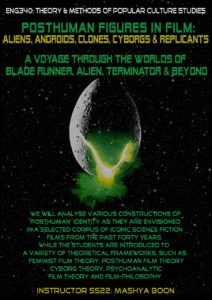
Gary Hoppenstand
ENG342.001: Readings in Popular Literary Genres
Topic: “Gumshoes, Shamuses, and P.I.s: The Golden Age of the Hard-Boiled Detective Story“
This class will examine the Golden Age of the Hard-Boiled Detective story, covering such notable authors as Dashiell Hammett, Raymond Chandler, and Erle Stanley Gardner. During the 1920s and 1930s, the Hard-Boiled Detective Story was a unique American literary invention. These novels articulated the cultural angst of the working classes and the rise in organized crime. They presented a singularly American protagonist who investigated crime on the “mean streets” of the big city, while maintaining a personal integrity that was often in conflict with the corrupt politicians and police officials who were often as guilty of violent crime as the gangsters. Adventure, tough characters, and an unfiltered look at the dark underbelly of American society, the novels and films to be covered in class will offer a glimpse at an America in need of a working-class hero.
Gary Hoppenstand
ENG478B.001: Literature and Visual Culture
Topic: “Swords and Sandals and the Hollywood Epic Motion Picture: The Ancient Roman World in Popular Film and Fiction”
By the early 1950s in America, television was making Hollywood bankrupt. The Hollywood movie studios had to come up with a plan to bring dwindling audiences back to the movie theater, and away from the small black-and-white television boxes that were a parasite to their entertainment industry. Hollywood’s decision was to make big-budget, widescreen, color epic movies that television could not compete with at that time, so from the early 1950s to the early 1960s, the ancient world movie epic dominated the box office and saved Hollywood. This class will study a number of these movie epics, including the first movie epic example from the period, Quo Vadis, which was an immediate smash with audiences, to the most expensive movie ever made (up until that time in the early 1960s), Cleopatra, which starred Elizabeth Taylor and Richard Burton. Also to be studied is the reincarnation of the classic movie epic today, such as the Ridley Scott film, Gladiator, which won numerous Academy Awards and popular acclaim. The ancient world epic, in both popular film and fiction, will be studied according to genre and narrative theory, as well as social cultural theory.
Justus Nieland
FLM400.001: Seminar: History of Film
Topic: “Substrates of Cinema: Infrastructure, Media, Logistics”
This class examines the relationship between film and infrastructure as intertwined modern technologies. From the Flint water disaster and the failures of the Texas electrical grid to debates about green energy and our climate crisis, infrastructure continues to demand attention and consume resources. How does film shape understandings of infrastructures as unseen but essential systems of modern living? What role has infrastructural cinema played in debates about citizenship, democracy, the scope of government, and visions of a just public life? Why has film and media studies returned to infrastructure in recent years? To answer questions like these, we’ll watch Hollywood spectacles, experimental and avant-garde works, and industrial films. We’ll also foster an infrastructural attentiveness to how and where media come from, what resources they consume and distribute, and how, elementally, they came to be what they are. The class aims to make visible the buried networks and systems that bring modern communities into being, inspire political activity and imagination, and organize bodies, labor, and commodities.
Summer 2021
Joshua Lam
ENG 130.732: Film and Society
Topic: “Horror Comedy”
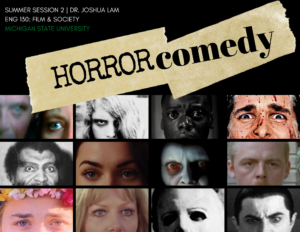 Have you ever been so frightened that you burst out laughing? Have you ever laughed until you cried? This online summer course looks at two popular film genres and their intersection: horror, comedy, and horror-comedy. As a genre, horror is often said to represent our collective fears. Yet humor, too, can be thought of as a way of managing anxiety. Both fear and laughter, after all, produce endorphins that we associate with pleasurable thrills and physical release. This course will function as an introduction to the genre of horror and the social fears it indexes, including ‘deviant’ sexualities, ‘primitive’ religions, toxic masculinity, xenophobia, the sociopathy of capitalism, and more. Students will learn some basic elements of film analysis and examine films in their social and historical contexts. We will pay special attention to the development of “horror-comedy,” from the unintentional humor of classic Hollywood monster movies, to campy exploitation films of the 1960s and 70s, to the biting satire of contemporary films like Get Out. Week-long units will focus on subgenres like slasher films, captivity narratives, possession, vampires, and zombies.
Have you ever been so frightened that you burst out laughing? Have you ever laughed until you cried? This online summer course looks at two popular film genres and their intersection: horror, comedy, and horror-comedy. As a genre, horror is often said to represent our collective fears. Yet humor, too, can be thought of as a way of managing anxiety. Both fear and laughter, after all, produce endorphins that we associate with pleasurable thrills and physical release. This course will function as an introduction to the genre of horror and the social fears it indexes, including ‘deviant’ sexualities, ‘primitive’ religions, toxic masculinity, xenophobia, the sociopathy of capitalism, and more. Students will learn some basic elements of film analysis and examine films in their social and historical contexts. We will pay special attention to the development of “horror-comedy,” from the unintentional humor of classic Hollywood monster movies, to campy exploitation films of the 1960s and 70s, to the biting satire of contemporary films like Get Out. Week-long units will focus on subgenres like slasher films, captivity narratives, possession, vampires, and zombies.
Julian Chambliss
ENG 342: Readings in Popular Lit Genres
Topic: “A Black Future Fantastic: Rayguns, Mystical Lands, and Powered Bodies”
This course examines the origins, evolution, and impact of futurism in African-American comics in the United States. From newspapers comic strips such as Neil Knight to contemporary comic books such as BLACK, students in this course will learn about the history and cultural narrative linked to futurity, comics, and race in the United States. The course will explore a variety of genres but focus on futurism as a guiding theme. What can comics provide in terms of future-oriented symbolism? In this course, we will see how comics capture progressive aspirations.
Lyn Goeringer
ENG 478A: Lit Tech & Representation
Topic: “Podcasting”
This online class summer course is an introduction to independent podcast production. Looking at narrative, documentary, investigative, artistic, and creative podcasting styles, this class teaches you how to make professional quality audio recordings with a cellphone or digital audio recorder, how to mix and arrange them on your own computer, and how to share them with the world. No experience required.
Jessica Travers
IAH 207.790: Lit, Cultures, Identities
Topic: “Looking at AIDS in America through Literature & Film”
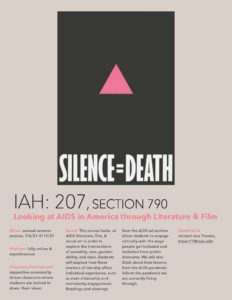 This course looks at AIDS literature, film, & visual art in order to explore the intersections of sexuality, race, gender, ability, and class. Students will explore how these markers of identity affect individual experience, such as state citizenship and community engagement. Readings and viewings from the AIDS art archive allow students to engage critically with the ways people get included and excluded from public discourse. We will also think about how lessons from the AIDS pandemic inform the pandemic we are currently living through.
This course looks at AIDS literature, film, & visual art in order to explore the intersections of sexuality, race, gender, ability, and class. Students will explore how these markers of identity affect individual experience, such as state citizenship and community engagement. Readings and viewings from the AIDS art archive allow students to engage critically with the ways people get included and excluded from public discourse. We will also think about how lessons from the AIDS pandemic inform the pandemic we are currently living through.
Jessica Stokes
IAH 207.792: Lit, Cultures, Identities
Topic: “(un)Natural Disasters”
What is (un)natural about a hurricane? Its causes? Its impacts?
This class questions the complexity of what “nature” means conceptually and how it’s mobilized in social and cultural contexts. Throughout the course, we will reflect on disaster movies, literature, current events, and cultural theory to sift through multiple, conflicting definitions of nature. These complexities, in turn, will be used to question how concepts such as race, sex, gender, and ability have been shaped in American culture through their relationships to the natural. In this course, we will consider who has been labeled “natural” or “unnatural” at different points in the history of the Americas, and we will analyze the consequences of these categories. Finally, we will connect so-called natural disasters to their sometimes human origins and their disproportionate impacts. By the end of the course, you will be prepared to articulate the ways in which cultural practices around nature change climates: both political and meteorological.
Fall 2020
Divya Victor
ENG 229: Introduction to Writing Poetry
Topic: “Sensing Life”
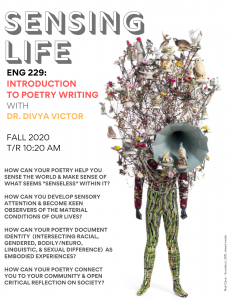 This course introduces students to the practice of writing poetry as an evolving genre of literature. The thematic and methodological focus for this course is “The Senses.” As such, students will undertake the embodied practices of observation, notation, recollection, cataloging, and re-enacting, while developing the critical skills of close-reading, literary analysis, researching, and proposing. Students will learn how to balance spontaneous and guided composition in a variety of organically defined forms in order to understand different modes of and approaches to poetry. Students will be introduced to a range of composition processes intended to stimulate frequent and adventurous writing, and will be encouraged to make disciplined and inventive use of the revision process. Through an experimental approach to writing, reading, and collaborative response, students will develop a vision for a longer-work that they will undertake for this course. Finally, they will grow as writers in a spontaneous community through a robust and compassionate approach to the peer-review process, in close consultation with their instructor.
This course introduces students to the practice of writing poetry as an evolving genre of literature. The thematic and methodological focus for this course is “The Senses.” As such, students will undertake the embodied practices of observation, notation, recollection, cataloging, and re-enacting, while developing the critical skills of close-reading, literary analysis, researching, and proposing. Students will learn how to balance spontaneous and guided composition in a variety of organically defined forms in order to understand different modes of and approaches to poetry. Students will be introduced to a range of composition processes intended to stimulate frequent and adventurous writing, and will be encouraged to make disciplined and inventive use of the revision process. Through an experimental approach to writing, reading, and collaborative response, students will develop a vision for a longer-work that they will undertake for this course. Finally, they will grow as writers in a spontaneous community through a robust and compassionate approach to the peer-review process, in close consultation with their instructor.
Emery Petchauer
ENG 308: Literature for Young Adults
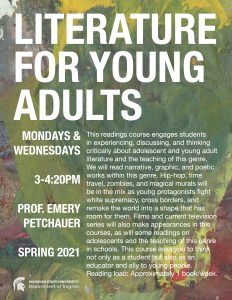 This readings course engages students in experiencing, discussing, and thinking critically about adolescent and young adult literature and the teaching of this genre. We will read narrative, graphic, and poetic works within this genre. Hip-hop, time travel, zombies, and magical murals will be in the mix as young protagonists fight white supremacy, cross borders, and remake the world into a shape that has room for them. Films and current television series will make appearances in this courses, as will some readings on adolescents and the teaching of this genre in schools. This course asks you to think not only as a student but also as an educator and ally to young people. Reading load: Approximately 1 book/week.
This readings course engages students in experiencing, discussing, and thinking critically about adolescent and young adult literature and the teaching of this genre. We will read narrative, graphic, and poetic works within this genre. Hip-hop, time travel, zombies, and magical murals will be in the mix as young protagonists fight white supremacy, cross borders, and remake the world into a shape that has room for them. Films and current television series will make appearances in this courses, as will some readings on adolescents and the teaching of this genre in schools. This course asks you to think not only as a student but also as an educator and ally to young people. Reading load: Approximately 1 book/week.
Joshua Lam
ENG 320A: Methodologies in Literary History: Genre
Topic: “Comedy”
Why do humans often laugh at the misfortunes of others? How does cruelty serve as material for our amusement? Comedy has been a genre of literature, speech, and performance for millennia, but there has been an abundance of so-called “dark humor” in the last two centuries—especially in the U.S. In an era of world wars, revolutions, nuclear conflicts, and environmental disasters, many writers have turned to satire, parody, and other forms of comedy to contemplate violence. Are they escapists? Apathetic? Cruel? Philosophers? This course will survey a broad range of American writers, thinkers, and performers in the twentieth and twenty-first centuries, following the theme and genre of “dark humor.” In addition to exploring different genres/media (fiction, film, poetry, stand-up) and movements (modernism, postmodernism), we will ask how American writers use comedy to respond to cultural problems such as war, sexism, racism, and inequality. We will ask: Why has the Holocaust been such fertile ground for comedians? Why do we laugh at jokes we regard as being in “bad taste”? Why are Nazis and policemen fodder for so much comedy? We will also look at several theories of comedy and laughter, and we will strive to take comedy seriously (but not too seriously). In addition to viewing comedy as a genre across various media, we will study its role in everyday life and culture, paying attention to our own senses of humor and habits of consumption. Units on modern and postmodern satire, subversive queer comedy, African American humor, and more, with longer texts by Don DeLillo, Fran Ross, Nathanael West, and Patricia Highsmith.
Shelia Contreras
ENG 320B: Methodologies in Literary History: Region
Topic: “US/Mexico Borderlands”
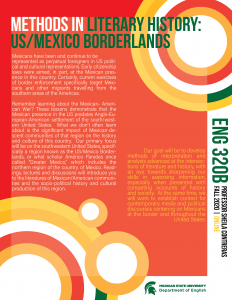 Mexicans have been and continue to be represented as perpetual foreigners in US political and cultural representations. Early citizenship laws were aimed, in part, at the Mexican presence in this country. Certainly, current exercises of border enforcement specifically target Mexicans and other migrants travelling from the southern areas of the Americas.
Mexicans have been and continue to be represented as perpetual foreigners in US political and cultural representations. Early citizenship laws were aimed, in part, at the Mexican presence in this country. Certainly, current exercises of border enforcement specifically target Mexicans and other migrants travelling from the southern areas of the Americas.
Remember learning about the Mexican-American War? These lessons demonstrate that the Mexican presence in the US predates Anglo-European-American settlement of the south/western United States. What we don’t often learn about is the significant impact of Mexican-descent communities of that region on the history and culture of this country. Our primary focus will be on the southwestern United States, specifically a region known as the US/Mexico Borderlands, or what scholar Américo Paredes once called “Greater Mexico,” which includes the northern region of the country of Mexico. Readings, lectures and discussions will introduce you to the literatures of Mexican/American communities and the socio-political history and cultural production of this region.
Our goal will be to develop methods of interpretation and analysis advanced at the intersections of literature and history, with an eye towards sharpening our skills in assessing information, especially when presented with competing accounts of history and society. At the same time, we will work to establish context for contemporary media and political discourses centering on Mexicans at the border and throughout the United States.
Sheng-mei Ma
ENG 352: Asian American Literature
American literature is crawling with Sinophobic viruses, from Bret Harte’s 1870 “The Heathen Chinee” to Trump’s crossing out “corona” in coronavirus and replacing it with “CHINESE” in caps with a sharpie. This course opens with “California Dreamin’”—with a touch of evil/yellow—by Jack London and Frank Norris. Such Sinophobia is compensated by mid-century Sinophilia in Beat poets, Philip K. Dick, and E. V. Cunningham. In between the two extremes are Asian American quest to heal itself, with unforeseen side effect, exemplified by Crazy Rich Asians, Gene Luen Yang, Ling Ma, Patricia Park, Alice Wu, and Lulu Wang. This course studies fiction, film, radio play, and graphics. Course grade is based on papers, exams, and class performance.
Sheng-mei Ma
ENG 360: Studies in Postcolonial Diaspora
Topic: “In Search of Alien”
This course explores the heart of postcolonial studies, the concept of alien in an “us v. them” divide. Starting from Edward Said’s classic Orientalism, supplemented by American stigma of Asians as “perennial aliens,” the course interrogates historical and current Sino-U.S. representations of alienation (alienAsian). We pair Bret Harte’s “Ah Sin” with Kevin Kwan a century later; Roman Polanski’s Chinatown with Frank Norris’ stories and novel; millennial China’s Detective Chinatown with the BBC’s Sherlock and Ruth Rendell; and more. We conclude with a unit on Afro-Asian filmic duet, where two U.S. minorities perform a pas de deux ever in danger of escalating into a duel. This course studies fiction, film, visual art, and graphics. Course grade is based on papers, exams, and class performance.
Natalie Phillips
ENG 364: Studies in 18th/19th Century Literature
Topic: “Fictions of Mind: Thinking and Feeling in Eighteenth-Century Literature”
How does literature represent the mind? What effect does reading literature have on thought and emotion? This course takes up these questions in a period where debates about cognition had become newly vibrant: the Enlightenment. Reading a range of historical works engaged with theories of the mind and brain, we will explore rationality and its discontents, the history of objectivity and memory, and depictions of cognitive control lost (absorption, obsession, and madness). As we look at the emerging aesthetics of mental states—e.g. curiosity, boredom, distraction, happiness, and desire—we will also consider the distinctly historical ways that eighteenth-century literature raced, gendered, classed, and sexed the body and mind. This course will incorporate interdisciplinary activities drawn from the Digital Humanities and Literary Cognition Lab (DHLC)’s Projects in the neuroscience of reading, poetry, and music as well as accessible art into course assignments. Students will learn to use new databases to explore literature’s connections with the history of science, engage interdisciplinary scholarship on theories of the mind, brain, and environment, and discuss new work in cognitive literary studies and the history of neuroscience.
Jyotsna Singh
ENG 368: Studies in Medieval/Early Modern Literature
This class will study connections between selected late Medieval and early modern literary works in England, with a comparative focus on Medieval influences on Shakespeare’s plays and their sources. Specifically, we will focus on how drama evolved from early biblical and morality plays in the 15thcentury to the complex, secular drama of the age of Shakespeare, from the late 16thcentury onwards.
Drama evolved from biblical stories, covering the Creation to the Last Judgement, often focusing on the divinity of Christ. Alongside these biblical plays, medieval audiences were also entertained by another kind of religious performance called the morality play, an allegorical drama popular in Europe in the 15thand 16thcenturies, in which the characters personify moral attributes of sin or virtue. For instance, the protagonist is a representative Christian figure like “Everyman” and “Mankind,” and istypically confronted by personified Sin of all magnitude (the seven deadly sins, the world, the flesh, the Devil, Vice, and so on). Notwithstanding religious themes, these plays were also infused with local idioms, folk traditions, and other entertainments, often involving buffoons and devils.
As English drama evolved, it became more secular and removed from its earlier didactic goals, moving through Tudor Interludes into the full flowering of Renaissance drama in Shakespeare’s plays. Drawing on selected plays, we will explore the relationships between the two dramatic movements and common themes and concerns they may share, such as the nature of evil, complexity of sins, as well as the familiar conflicts between virtue and vice. For instance, the psychological struggles of Shakespeare’s characters are reminiscent ofpsychomachiasor conflicts between good and evil faced by allegorical figures like “Everyman” in Medieval drama. In addition to literary works, we will read historical and cultural works on the MSU Libraries electronic website, Early English Books on Line (EEBO).
1. Four MoralityPlays (The Penguin English Library) (NOT in SBS)
2. Everyman and Mankinded. Doug Bruster.
3. Everyman and other Miracle and Morality Plays Dover Thrift ed.
4. Shakespeare,The Winter’s Tale(Penguin)
5. Shakespeare,Richard III, (Penguin)
6. Shakespeare,Macbeth (Simon and Schuster)
7. Shakespeare,Cymbeline, (Simon and Schuster)
Gary Hoppenstand
ENG 391: Special Topics in English
Topic: “Popular Genre Fiction”
Popular genre fiction provides critical insights into the human condition. Categories such as romance fiction, science fiction and fantasy, detective fiction, horror fiction, and the thriller offer bestsellers that reflect, as well as affect, society. This class will examine the above popular genres through the lens of World War Two, discussing how this historical moment in society is interpreted by these different approaches to storytelling.
Juliet Guzzetta
ENG 426/ENG 826: Special Topics Seminar
Topic: “Performing Solo and Performance Theory”
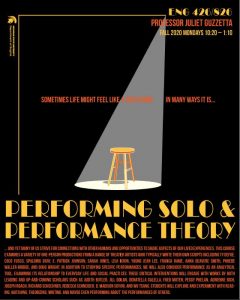 Sometimes life might feel like a solo show. In many ways it is. And yet many of us strive for connections with other humans and opportunities to share aspects of our lived experiences. This course examines a variety of one-person productions from a range of theater artists who typically write their own scripts including Ty Defoe, Coco Fusco, Spalding Gray, E. Patrick Johnson, Sarah Jones, Lisa Kron, Young Jean Lee, Franca Rame, Anna Deavere Smith, Phoebe Waller-Bridge, and Doug Wright. In addition to studying specific performances, we will also consider performance as an analytical tool, examining its relationship to everyday life and social practices. These critical interventions will engage with works by both leading and up-and-coming scholars such as Judith Butler, Jill Dolan, Donatella Galella, Fred Moten, Peggy Phelan, Adrienne Rich, Joseph Roach, Richard Schechner, Rebecca Schneider, D. Madison Soyini, and Wu Tsang. Through primary and secondary texts, students will explore and experiment with reading, watching, theorizing, writing, and maybe even performing about the performances of others.
Sometimes life might feel like a solo show. In many ways it is. And yet many of us strive for connections with other humans and opportunities to share aspects of our lived experiences. This course examines a variety of one-person productions from a range of theater artists who typically write their own scripts including Ty Defoe, Coco Fusco, Spalding Gray, E. Patrick Johnson, Sarah Jones, Lisa Kron, Young Jean Lee, Franca Rame, Anna Deavere Smith, Phoebe Waller-Bridge, and Doug Wright. In addition to studying specific performances, we will also consider performance as an analytical tool, examining its relationship to everyday life and social practices. These critical interventions will engage with works by both leading and up-and-coming scholars such as Judith Butler, Jill Dolan, Donatella Galella, Fred Moten, Peggy Phelan, Adrienne Rich, Joseph Roach, Richard Schechner, Rebecca Schneider, D. Madison Soyini, and Wu Tsang. Through primary and secondary texts, students will explore and experiment with reading, watching, theorizing, writing, and maybe even performing about the performances of others.
Joshua Lam
ENG 450/ENG 814: Seminar in African American Lit
Topic: “US Modernsim in Black and White”
How has racial difference been inscribed in the creation and canonization of modernist aesthetics in the US? While race has long been regarded as central to the creation of American modernity, scholars and publishers have often regarded the modernist aesthetics of canonical figures like Gertrude Stein, T.S. Eliot, and Ezra Pound as distinct from African American literary aesthetics of the same era, including those associated with the Harlem Renaissance and the “New Negro” movement. This course will examine both canonical and lesser-known texts from “traditional” (ostensibly white) modernism and African American modernism, framed by recent critical attempts to think against or complicate this putative divide. Our historical scope will be broad; we will read literature from the post-Reconstruction era; canonical modernist figures; “New Negro” writers and anthologies; and a number of authors who resist placement in these lineages and milieus. We will also examine scholarly attempts to complicate or challenge the notion that white and black writers created what Michael North calls “two different modernisms.” These include interdisciplinary and historical accounts of “Jim Crow Modernism”; investigations of racial imitation and masquerade; narratives of passing and queer of color critique; and scholarship on sound and recording technologies (e.g., sonic Afro-modernity). Longer texts may include works by Nella Larsen, Jean Toomer, Zora Neale Hurston, Claude McKay, Richard Wright, and Gertrude Stein; poetry by Langston Hughes, Countee Cullen, Gwendolyn Brooks, T. S. Eliot, and more.
Natalie Phillips
ENG 457: Literary Cognition
Topic: “Cognitive Science, Medicine, & the History of the Mind”
This course interweaves three interdisciplinary fields in literary studies: cognitive approaches to literature, the history of mind, and medical humanities. Discussing intersections in literary and medical portrayals of cognition from Austen’s Persuasion to The Curious Incident of the Dog in the Night-Time, we explore pivotal moments in the history of the mind and brain, beginning in the eighteenth century and ending with the DSM-5, self-described as “the standard classification of mental disorders used by mental health professionals in the U.S.” As we consider the literary history of modern diagnostic categories such as autism spectrum, attention deficit, and OCD (including depictions of distraction in Tristram Shandy, Jane Austen’s use of contemporary theories of head injury, and modern portrayals of disability in YA fiction), we will also explore therapeutic uses of literature, music, and art in proposed clinical treatments of everything from depression, anxiety, and PTSD to stuttering. Throughout, we will read key works in cognitive approaches to fiction, disability studies, and medical humanities, exploring both the power—and the profound challenges—of integrating scientific and literary-critical approaches to conduct authentically interdisciplinary work in medical humanities. This course will incorporate interdisciplinary activities drawn from the Digital Humanities and Literary Cognition Lab(DHLC)’s Projects in the neuroscience of reading, poetry, and music as well as accessible art.In particular, students will work in groups to brainstorm and design an interdisciplinary experiment that imagines using technologies from cognitive science—such as fMRI (functional magnetic resonance imaging), EEG, or eye-tracking—to explore a central question at the intersection of literature and medicine.
Stephen Deng
ENG 484C: Critical Questions in a Literary Period
Topic: “Early Modern English Literature”
This course serves as a “capstone” to the English major. It is designed to bring together the various skills you have learned from your English courses thus far (close reading, engaging with secondary sources and literary theory, interpreting a literary text from within historical contexts, structuring a literary essay and developing a solid thesis), as well as to allow you to engage in more extensive research on a particular critical problem in early modern literary criticism, especially through primary research of contextual early modern texts in Early English Books Online. The course will culminate in a “mini-conference” across the final weeks and a thesis-like essay of 15-20 pages, which could serve as a writing sample for those intending to attend graduate school. Moreover, the bulk of the course is organized as a series of presentations by students in order to provide an oral interactive experience that will benefit students for whatever field they choose to pursue after MSU.
The course will then be run as a workshop – each student will prepare several 5-15 minute presentations throughout the semester, which will constitute the largest grade component. During the semester the students will hand in an annotated bibliography of primary and secondary materials consulted for the project. And a final 15-20 minute presentation will be given at a “mini-conference” during the end of the semester, in which students will present their final projects while getting valuable feedback from the class in preparation for the final essay.
Rick Blackwood
FLM 255.001: Stars and Directors
Topic: “Kubrick and his Contemporaries”
Offers a survey of Kubrick’s works, emphasizing the influences of filmmakers Kubrick admired, like Max Ophüls, and comparing and contrasting Kubrick with contemporaries, particularly Coppola, Scorsese, and Oliver Stone. Particular intellectual emphasis will focus on thinkers and philosophers admired, and critiqued by this generation of filmmakers, such as Freud, Machiavelli, and Nietzsche.
Peter Johnston
FLM 335: Film Directing
Part of the Fiction Film Specialization, Film Directing immerses students in the job of the director through a combination of film screenings and production projects. By studying the works of great directors, and working through a series of filmmaking projects which culminates in the creation of a 3-minute short, students learn first hand the challenges and triumphs of Film Directing.
John Valadez
FLM 411/MI 211: Documentary Design/Production
Design and development of documentaries in a team setting using video and audio. Participation in a production cycle including idea generation, research, design, production, and distribution.
Rick Blackwood
FLM 434: Advanced Screenwriting
Offers undergraduate students a continuation of projects begun in ENG/FLM 334, and allows students to complete a screenplay in one semester. On a theoretical level, attention is directed toward the socioeconomic organization of the society that makes the American film business what it is, and that defines the relationship between the film artist in America and his/her artistic, and material, circumstances.
Julian Chambliss
IAH 207
Topic: “Afrofantastic: Race, Power, and Gender in the Black Imaginary”
Since the 1990s, we have seen an explosion of speculative art rooted in the black diasporic experience. Spanning media and crossing borders, the speculative work offered by these voices has coalesced into a movement broadly defined as Afrofuturism. This course examines the definition, historical roots, and contemporary expression of Afrofuturism. Our current Afrofuturist moment is the latest expression of a black imaginary with a deep cultural legacy. We will uncover the theory and examine the practice that shapes black futurity.
Gary Hoppenstand
IAH 221C
Topic: “The Hero’s Journey: Heroic Fantasy in American Popular Fiction”
This class will examine heroic fantasy in American popular fiction. Thematic issues such as Joseph Campbell’s “the hero’s journey” and comparative myth structures will provide the foundation of the course, which will cover such topics as “High Fantasy,” “Low Fantasy,” “Dark Fantasy, and Grimdark Fantasy.” Authors to be covered include J.R.R. Tolkien, Robert E. Howard, and Catherine L. Moore. From The Hobbit to The Witcher, fantasy stories in popular fiction featuring diverse cultures and mythologies will be covered, as read by American audiences, including novels that explore African heroic fantasy and Mid-Eastern heroic fantasy, and well as heroic fantasy novels that feature powerful women protagonists.
Spring 2021
Sheng-mei Ma
ENG 210.003: Intro to English
Topic: “Classic Redux, Anglo Asianized
Quite a few canonical classics inspire contemporary Asian American and Asian artists, who remake and recontextualize the classics. The Scarlet Letter weaves itself into Updike’s epistolary S and Ng’s Little Fires Everywhere. Jane Eyre morphs into Re Jane. George Romero’s zombie trilogy is reanimated in Severance, not to mention Severance’s zombie girl behind the red curtains, a scene straight out of Charlotte Bronte. All such makeovers share in an Orientalizing of the West. Even the Chinese animation Nezha draws from the legends of Monkey King and the Boy God Nezha. Nezha belongs to the eternal return of this Oedipus-Loki-trickster “with Chinese characteristics.” We focus on modern and contemporary retellings, with the classics in excerpts setting the stage. Course grade is based on research papers, critical analyses, the final exam, and class performance.
Divya Victor
ENG 223: Introduction to Writing Creative Nonfiction
Topic: “Sensing Life”
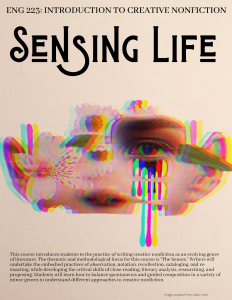 This course introduces students to the practice of writing creative nonfiction as an evolving genre of literature. The thematic and methodological focus for this course is “The Senses.” Writers will undertake the embodied practices of observation, notation, recollection, cataloging, and re-enacting, while developing the critical skills of close-reading, literary analysis, researching, and proposing. Students will learn how to balance spontaneous and guided composition in a variety of minor genres to understand different approaches to creative nonfiction. Students will be introduced to a range of composition processes intended to stimulate frequent and adventurous writing, and will be encouraged to make disciplined and inventive use of the revision process. Through an experimental approach to writing, reading, and collaborative response, students will develop a vision for a longer-work that they will undertake for this course. Finally, they will grow as writers in a spontaneous community through a robust and compassionate approach to the peer-review process, in close consultation with their instructor.
This course introduces students to the practice of writing creative nonfiction as an evolving genre of literature. The thematic and methodological focus for this course is “The Senses.” Writers will undertake the embodied practices of observation, notation, recollection, cataloging, and re-enacting, while developing the critical skills of close-reading, literary analysis, researching, and proposing. Students will learn how to balance spontaneous and guided composition in a variety of minor genres to understand different approaches to creative nonfiction. Students will be introduced to a range of composition processes intended to stimulate frequent and adventurous writing, and will be encouraged to make disciplined and inventive use of the revision process. Through an experimental approach to writing, reading, and collaborative response, students will develop a vision for a longer-work that they will undertake for this course. Finally, they will grow as writers in a spontaneous community through a robust and compassionate approach to the peer-review process, in close consultation with their instructor.
Stephen Deng
ENG 318: Readings in Shakespeare
For over 400 years, readers and play-goers have been entranced by the language, imagery, themes, narratives, and sometime emotional roller-coasters of Shakespeare’s works. As I hope you find in this course, Shakespeare’s writings have much to say not only about his own culture but also about our own. Moreover, the richness of his texts offers an abundance of potential for various critical approaches. We begin this course with political, religious, and social background on Shakespeare’s England, including the material conditions of textual and theatrical production. By doing so, I hope to be able to provide a foundation for understanding how “Shakespeare” as we know the phenomenon emerged from a particular situation within history and the history of literature. We then proceed to seven plays chosen across Shakespeare’s career and across genres (comedy, tragedy, tragicomedy, history and romance)—Titus Andronicus, Richard II,The Merchant of Venice, Twelfth Night, Measure for Measure, Othello, and The Tempest—as well as a brief stint in the middle of the semester on Shakespeare’s sonnets. We will approach the plays and poems from a variety of perspectives such as anthropological, post-colonial, historiographic, economic, and socio-political, as well as those that apply early modern theories of genre, gender, sexuality and race. Much of our class discussions will focus on close reading particular passages from the texts, though we will also explore performances of the plays through film clips. Our textual analysis in class should help students in preparing two 5-6 page critical essays, which should perform close readings of a work within a clearly structured argument. In addition to the essays, there will be a midterm, a final exam, and several unannounced reading quizzes throughout the term.
Joshua Lam
ENG 320A: Methodologies in Literary History: Genre
Topic: “Comedy”
Why do humans often laugh at the misfortunes of others? How does cruelty serve as material for our amusement? Comedy has been a genre of literature, speech, and performance for millennia, but there has been an abundance of so-called “dark humor” in the last two centuries—especially in the U.S. In an era of world wars, revolutions, nuclear conflicts, and environmental disasters, many writers have turned to satire, parody, and other forms of comedy to contemplate violence. Are they escapists? Apathetic? Cruel? Philosophers? This course will survey a broad range of American writers, thinkers, and performers in the twentieth and twenty-first centuries, following the theme and genre of “dark humor.” In addition to exploring different genres/media (fiction, film, poetry, stand-up) and movements (modernism, postmodernism), we will ask how American writers use comedy to respond to cultural problems such as war, sexism, racism, and inequality. We will ask: Why has the Holocaust been such fertile ground for comedians? Why do we laugh at jokes we regard as being in “bad taste”? Why are Nazis and policemen fodder for so much comedy? We will also look at several theories of comedy and laughter, and we will strive to take comedy seriously (but not too seriously). In addition to viewing comedy as a genre across various media, we will study its role in everyday life and culture, paying attention to our own senses of humor and habits of consumption. Units on modern and postmodern satire, subversive queer comedy, African American humor, and more, with longer texts by Don DeLillo, Fran Ross, Nathanael West, and Patricia Highsmith.
David Stowe
ENG 340: Popular Culture Studies
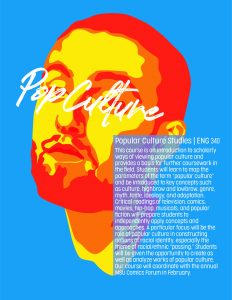 This course is an introduction to scholarly ways of viewing popular culture and provides a basis for further coursework in the field. Students will learn to map the parameters of the term “popular culture,” and will be introduced to key concepts such as culture, highbrow and lowbrow, genre, myth, taste, ideology, and adaptation. Critical readings of forms like television, comics, movies, hip-hop, musicals, and popular fiction will prepare students to independently apply concepts, approaches and theories. Students will be guided through explorations of semiotic, narrative, psychoanalytic, economic, and sociological criticism with an eye to media industry practices. A particular focus will be the role of popular culture in constructing notions of racial and ethnic identity, especially the theme of racial/ethnic “passing.” Students will be given the opportunity to create works of popular culture as well as to analyze them. Our course will coordinate with events sponsored by Special Collections in the MSU Library as well as the annual MSU Comics Forum in February.
This course is an introduction to scholarly ways of viewing popular culture and provides a basis for further coursework in the field. Students will learn to map the parameters of the term “popular culture,” and will be introduced to key concepts such as culture, highbrow and lowbrow, genre, myth, taste, ideology, and adaptation. Critical readings of forms like television, comics, movies, hip-hop, musicals, and popular fiction will prepare students to independently apply concepts, approaches and theories. Students will be guided through explorations of semiotic, narrative, psychoanalytic, economic, and sociological criticism with an eye to media industry practices. A particular focus will be the role of popular culture in constructing notions of racial and ethnic identity, especially the theme of racial/ethnic “passing.” Students will be given the opportunity to create works of popular culture as well as to analyze them. Our course will coordinate with events sponsored by Special Collections in the MSU Library as well as the annual MSU Comics Forum in February.
Gary Hoppenstand
ENG 342: Readings in Popular Lit Genres
This class will examine heroic fantasy in American popular fiction. Thematic issues such as Joseph Campbell’s “the hero’s journey” and comparative myth structures will provide the foundation of the course, which will cover such topics as “High Fantasy,” “Low Fantasy,” “Dark Fantasy, and Grimdark Fantasy.” Authors to be covered include J.R.R. Tolkien, Robert E. Howard, and Catherine L. Moore. From The Hobbit to The Witcher, fantasy stories in popular fiction featuring diverse cultures and mythologies will be covered, as read by American audiences, including novels that explore African heroic fantasy and Mid-Eastern heroic fantasy, and well as heroic fantasy novels that feature powerful women protagonists.
Divya Victor
ENG 429: Advanced Poetry Writing
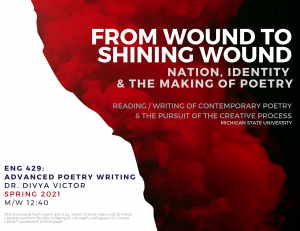 The fundamental goal of this course is to help you develop effective, sustainable, and socially meaningful practices for writing through the genre of poetry. You will develop a broader and deeper understanding of poetry as a literary form and artistic practice. You will become familiar with a broad range of poetic practices and use these as launch pads for improvising and developing a critical understanding of poetry as an expressive form of political and cultural engagement. You will explore new compositional methods through experimentation, workshop critique, and collaboration. The course is structured as both a conventional seminar and a workshop. Our sessions will be devoted (in approximately equal parts) to the work of established contemporary poets, the work of your peers, and the experiment-based play of your weekly poetry assignments.
The fundamental goal of this course is to help you develop effective, sustainable, and socially meaningful practices for writing through the genre of poetry. You will develop a broader and deeper understanding of poetry as a literary form and artistic practice. You will become familiar with a broad range of poetic practices and use these as launch pads for improvising and developing a critical understanding of poetry as an expressive form of political and cultural engagement. You will explore new compositional methods through experimentation, workshop critique, and collaboration. The course is structured as both a conventional seminar and a workshop. Our sessions will be devoted (in approximately equal parts) to the work of established contemporary poets, the work of your peers, and the experiment-based play of your weekly poetry assignments.
Gary Hoppenstand
ENG 478B/ ENG 818: Literature and Visual Culture
Topic: “The Popular Detective Story in Fiction and Film”
This class will discuss the various theories of popular fantasy narratives as they apply to fiction and film. Thematically, we will examine the narrative range of fantasy from High Fantasy to Grimdark Fantasy, with an understanding that fantasy employs a narrative genre that explores the “real world” human condition through secondary worlds of imagination.
Sheng-mei Ma
ENG 492H: Honors Seminar in English
Topic “Chinee: Toward a US Stereotype”
Bret Harte’s 1870 poem “The Heathen Chinee” on a duplicitous Chinese card shark crystallizes the West Coast nativist “The Chinese Must Go!” movement and heralds the Chinese Exclusion Act (1882-1943). The racial other’s physical features are first stereotyped and then decoded for intentionality, a fixation on turning unknown, evolving individuals into known, fixed types. Us in the US is thus pitted against Them, the perennial aliens. The deboning of “s” from “Chinese” produces the long “e” suffix, an alleged linguistic trait of coolies’ pidgin. Yet such stereotypes are symptomatic of our own semantic (auditory) and, increasingly, cinematic (visual) Orientalism. Nobel laureate John Steinbeck in East of Eden (1952) continues this time-honored American tradition in Lee, the Chinese servant-nanny-surrogate mother and wife, who parrots: “Dlinkee Chinee fashion.” Steinbeck’s biblical allegory sprouts in part from Lee, the East in Eden. After select canonical (read: white) American fiction and film, we proceed to Asian American (off-white, yellow-ish) correction to white discursive supremacy. The ethnic pushback comes with its own side effect on skin and speech: either self-Orientalizing yellowface speaking in Anglophone monolingualism, exemplified by Crazy Rich Asians (2013, 2018) and Severance (2018), or ethnic comedies of global fusion in the likes of Saving Face (2004), Re Jane (2015), and The Farewell (2019). Course grade is based on research papers, critical analyses, the final exam, and class performance.
John Valadez
FLM 255: Starts and Directors
Topic: “FAME Celebrity, Infamy, the Promise and Peril of being Different While Being in the Spotlight”
Celebrity culture has always been an important part of human society, but what happens after the curtain call, when the stage lights fade and human ambition meets human frailty? What happens when someone gains renowned but the world moves on, either to forget or condemn? From Marlin Brando to Imelda Marcos to Amy Winehouse, from the Rolling Stones to Kenneth Lay and Jeffry Skilling, to Leni Reifenstahl to Orson Welles, this course will use documentary film to look behind the gilded gates of talent and fortune…what could possibly go wrong?
Peter Johnston
FLM 260: Introduction to Digital Film & Media
What’s changed in filmmaking technology in the past 20 years, and what impact does that have on the stories we tell? Have digital image-making tools, editing software, and distribution channels fundamentally changed the types of stories being told and the types of artists telling them? In this hybrid course we introduce students to a variety of emerging filmmaking technologies and give them a grounding in technical skills necessary to then move on to higher order concerns of storytelling. We screen, analyze and discuss new works and look over the evolution of filmmaking technology and how it relates to this historical moment. And students produce a variety of work in documentary, fiction, and experimental forms, focusing on iteration and repetition to hone filmmaking skills.
John Valadez
FLM 311/MI 311: Introduction to Documentary Production
Design and development of documentaries in a team setting using video and audio. Participation in a production cycle including idea generation, research, design, production, and distribution.
Joshua Yumibe
FLM 480: Seminar in Film Theory
Topic: “Cinema and the Archive”
In 1898, Boleslas Matuszewski, a Polish cameraman working for the Lumière Brothers, published one of the earliest proposals for a film archive in the French newspaper Le Figaro: “It would suffice to assign to cinematographic prints that have a historical character a section of the museum, a shelf in the library, a cabinet in the archives.” His intention was to make films available for scholarly inquiry: “animated photography will thus become an agreeable method for studying the past.” Taking a pointer from Matuszewski, we will explore in this class film’s archival relationship to the past, both in terms of what it represents and also in terms of the material history that is etched into films themselves. Scratches, fading colors, and decomposing emulsion attest to the provenanceof the medium, how time itself leaves its material traces on filmic objects as they circulate around the world. If film is a medium beholden to time, we will also explore the institutional ways in which film archives have developed over the last century to preserve the material legacies and as well as nurture the cultural heritage of the cinematic artifact.
Potential topics:
• Archival theories and practices, as developed by Paolo Cherchi Usai, Giovanna Fossati, and Catherine Russell
• Institutional histories: the British Film Institute; the Cinémathèque française, the Museum of Modern Art’s cinema collections (Haidee Wasson), EYE-Film, Amsterdam (Bregt Lameris), early ethnographic film at the American Museum of Natural History (Alison Griffiths), experimental cinema and Anthology Film Archives
• Gaps in the archive, e.g. Allyson Nadia Field’s work on the “nonextant” and early African American cinema, filmic reconstructions (e.g. Bezhin Meadow, Greed)
• Case studies: the Library of Congress’s paper print collection, The Davide Turconi and Josef Joye Collections, the Desmet Collection, found footage and recycled cinema (e.g. A Movie, Eureka, Film Ist, Decasia,and Lyrical Nitrate), MSU Special Collections
• Film archiving in the digital age (They Shall Not Grow Old)
Summer 2020
Joshua Lam
ENG 130: Film and Society
Topic: “Horror Comedy”
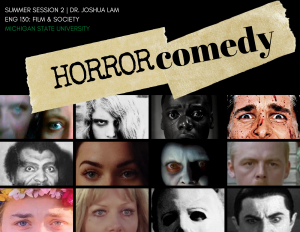 Have you ever been so frightened that you burst out laughing? Have you ever laughed until you cried? This online summer course looks at two popular film genres and their intersection: horror, comedy, and horror-comedy. As a genre, horror is often said to represent our collective fears. Yet humor, too, can be thought of as a way of managing anxiety. Both fear and laughter, after all, produce endorphins that we associate with pleasurable thrills and release. This course will function as an introduction to the genre of horror and the social fears it indexes, including ‘deviant’ sexualities, primitive religions, toxic masculinity, xenophobia, the sociopathy of capitalism, and more. Students will learn basic elements of film analysis and examine films in their social and historical contexts. We will pay special attention to the development of “horror-comedy,” from the unintentional humor of classic Hollywood monster movies, to campy exploitation films of the 1960s and 70s, to the biting satire of contemporary films like Get Out. Week-long units will focus on subgenres like slasher films, captivity narratives, possession, vampires, zombies, and folk horror.
Have you ever been so frightened that you burst out laughing? Have you ever laughed until you cried? This online summer course looks at two popular film genres and their intersection: horror, comedy, and horror-comedy. As a genre, horror is often said to represent our collective fears. Yet humor, too, can be thought of as a way of managing anxiety. Both fear and laughter, after all, produce endorphins that we associate with pleasurable thrills and release. This course will function as an introduction to the genre of horror and the social fears it indexes, including ‘deviant’ sexualities, primitive religions, toxic masculinity, xenophobia, the sociopathy of capitalism, and more. Students will learn basic elements of film analysis and examine films in their social and historical contexts. We will pay special attention to the development of “horror-comedy,” from the unintentional humor of classic Hollywood monster movies, to campy exploitation films of the 1960s and 70s, to the biting satire of contemporary films like Get Out. Week-long units will focus on subgenres like slasher films, captivity narratives, possession, vampires, zombies, and folk horror.
Marisa Mercurio
ENG 140: Literature and Society
Topic: “Gender in Gothic Horror”
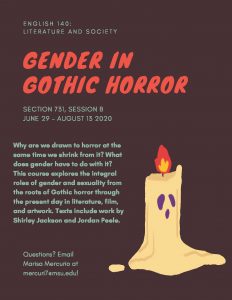 We will explore gender in the literature, art, and film of Gothic horror through an intersectional approach (e.g. also attending to sexuality, race, etc.), beginning briefly in the 19th century and making our way through the 21st century. Material will include texts like The Haunting of Hill House by Shirley Jackson and Us, dir. Jordan Peele.
We will explore gender in the literature, art, and film of Gothic horror through an intersectional approach (e.g. also attending to sexuality, race, etc.), beginning briefly in the 19th century and making our way through the 21st century. Material will include texts like The Haunting of Hill House by Shirley Jackson and Us, dir. Jordan Peele.
Why are we drawn to horror at the same time we shrink from it? What does gender have to do with it? This course explores the integral roles of gender and sexuality from the roots of Gothic horror through the present day in literature, film, and artwork. Texts include work by Shirley Jackson and Jordan Peele.
Most material will be available through D2L. The course will offer content warnings to the best of my ability and can offer substitute texts if requested.
Questions? Email Marisa Mercurio at mercuri7@msu.edu!
Kiana Gonzalez-Cedeno
ENG 142: Introduction to Popular Literature
In this course we will explore literature written in the 21st century by Women of Color. We will
read award winning literature that will challenge our understanding of the world around us
through their raw and ground breaking prose. As a student, you will gain valuable information
about People of Color and the challenges Black, Indigenous, and Latinx Women are
encountering-still- in the 21st century. The goal of this class is to introduce students to
established authors, as well as, up and coming authors that, regardless of writing in the margins,
have much to say regarding what we conceive of popular culture, the United States, and the
world.
Bria Harper
ENG 210.731: Foundations of Literary Study I
Topic: “Contemporary African American Literature”
This course is designed to introduce students to a variety of literature by African American novelists, poets, musicians, and artists that are not generally taught in classrooms.
This online summer course is a survey of different mediums of African American literature in order to engage the ways that these texts engage with conversations around current events.
Through looking at the texts are artists such as Morgan Parker, Eve Ewing, Danez Smith, Childish Gambino, Kendrick Lamar, and Beyoncé guide us in examining new ways to view literature as not just words on a page but written and spoken narratives of our own lives. You do not have to have a background in African American Literature to take this course.
This course is designed to be accessible to students everywhere.
Email me at harper54@msu.edu if you have any questions.
Lamar Johnson
ENG 308: Young Adult Literature
How are authors challenging inequality based on race, ethnicity, class, gender identity, sexuality, religion, disability, language, and intersections through their writing? The major aim of this class is to read, discuss, appreciate, and explore various themes that are common in young adult literature. In addition, we will read, analyze, and discuss multiple theoretical frameworks for analyzing YA fiction and nonfiction texts. You will read a variety of YAL texts that explore critical issues such as (racism, sexism, classism, nationality, etc.). This course will also explore a variety of teaching strategies for the instruction of young adult literature.
Jonathan Thurston
ENG 318: Introduction to Shakespeare
In 21st century America, Shakespeare is a popular name. You might know him for his famously romantic poetry, his “to be or not to be” soliloquy, or even the play Romeo and Juliet. With this course, I hope to challenge many of your preconceived notions of the Bard. This course will focus on the ways that we can read Shakespeare as relevant to today’s culture and times as well as his. The course will start with an introduction to the kinds of texts Shakespeare was reading at the time, sources like Ovid and Petrarch. Reading these texts will hopefully give you a foundation for reading Shakespeare as artistic not just for his imagination but also his politics and ability to make texts relevant for a contemporary audience. Then, we will segue into four different plays across Shakespeare’s career and different genres: Othello, Titus Andronicus, The Tempest, and Midsummer Night’s Dream. The course will focus on readings of Shakespeare’s works that prioritize historical and cultural implications, especially for sex, gender, and race.
William Johnsen
ENG 328: Reading in Novel & Narrative
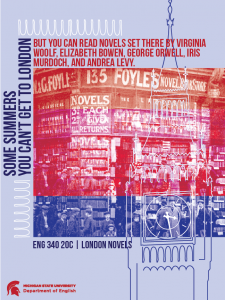 Some summers you can’t get to London but you can read novels set there by Virginia Woolf, Elizabeth Bowen, George Orwell, Iris Murdoch, and Andrea Levy. Each of these authors has their own London and we will use electronic resources to recreate their specific historical moment, including London just after war, during war, postwar, and the early years of the Windrush generation that emigrated from Jamaica to London, to ‘the mother country.’ Their special attention to city life has attracted a film version to each of these novels except one, and we will attend to that way of novel-reading as well.
Some summers you can’t get to London but you can read novels set there by Virginia Woolf, Elizabeth Bowen, George Orwell, Iris Murdoch, and Andrea Levy. Each of these authors has their own London and we will use electronic resources to recreate their specific historical moment, including London just after war, during war, postwar, and the early years of the Windrush generation that emigrated from Jamaica to London, to ‘the mother country.’ Their special attention to city life has attracted a film version to each of these novels except one, and we will attend to that way of novel-reading as well.
Kylene Cave
ENG 342: Readings in Popular Literary Genres
This course investigates literary genres and formula fiction through the lens of popular culture studies. Using a variety of mediums we will consider how certain popular genres emerged and how they have evolved over time in response to cultural shifts.
Sheng-mei Ma
ENG 360: Postcolonial Literature
Topic: “In Search of Alien”
This course explores the heart of postcolonial studies, the concept of alien in an “us v. them” divide. Starting from Edward Said’s classic Orientalism, supplemented by American stigma of Asians as “perennial aliens,” the course interrogates historical and current Sino-U.S. representations of alienation (alienAsian). We pair Bret Harte’s “Ah Sin” with Kevin Kwan a century later; Roman Polanski’s Chinatown with Frank Norris’ stories and novel; millennial China’s Detective Chinatown with the BBC’s Sherlock; and more. We conclude with a unit on Afro-Asian filmic duet, where two U.S. minorities perform a pas de deux ever in danger of escalating into a duel. This course studies fiction, film, visual art, and graphics. Course grade is based on papers, exams, and class performance.
Lyn Goeringer
ENG 478A: Lit Tech & Representation
This online class summer course is an introduction to independent podcast production. Looking at narrative, documentary, investigative, artistic, and creative podcasting styles, this class teaches you how to make professional quality audio recordings with a cellphone or digital audio recorder, how to mix and arrange them on your own computer, and how to share them with the world. No experience required.
Who this course is great for:
Writers who want to find a new outlet for their work
People wanting to make documentary pieces
Anyone who wants to consider storytelling as an auditory practice
People who want to engage in experimental story making
Anyone who wants to know more about sound/sound editing practices (It’s great for filmmakers!)
Anyone who wants to play with sounds, recording technologies, and more
You can do the work for this class anywhere.
Bill Vincent
FLM 355: Studies in Film Genres
Topic: “The Western”
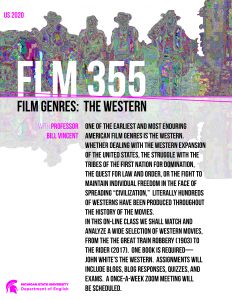 One of the earliest and most enduring American film genres is the western. Whether dealing with the western expansion of the United States, the struggle with the tribes of the First Nation for domination, the quest for law and order, or the fight to maintain individual freedom in the face of spreading “civilization,” literally hundreds of westerns have been produced throughout the history of the movies. In this on-line class we shall watch and analyze a wide selection of western movies, from The Great Train Robbery (1903) to The Rider (2017). One book is required – John White’s ‘The Western.’ Assignments will include blogs, blog responses, quizzes, and exams. A once-a-week zoom meeting will be scheduled.
One of the earliest and most enduring American film genres is the western. Whether dealing with the western expansion of the United States, the struggle with the tribes of the First Nation for domination, the quest for law and order, or the fight to maintain individual freedom in the face of spreading “civilization,” literally hundreds of westerns have been produced throughout the history of the movies. In this on-line class we shall watch and analyze a wide selection of western movies, from The Great Train Robbery (1903) to The Rider (2017). One book is required – John White’s ‘The Western.’ Assignments will include blogs, blog responses, quizzes, and exams. A once-a-week zoom meeting will be scheduled.
Sheng-mei Ma
IAH 211B: Area Studies and Multicultural Civilizations: Asia (I)
Topic: “Cool Outlaw and Lawman, East and West, in Words and Pictures”
Cool outlaw in both East and West has been hot, firing up public imagination from medieval Robin Hood ballads and Outlaws of the Marsh (Shuihu Zhuan) to the BBC’s Sherlock and the millennial China’s Detective Chinatown. Law-abiding readers and moviegoers project their discontent and rebellious impulse onto outlaws. Such transgressive flirting is counterpointed by a fascination with lawman, be it the rational genius of Howard Fast’s nisei Detective Masao Masuto or Ruth Rendell’s The Speaker of Mandarin. Indeed, the thin line between outlaw and lawman, violence and justice, cold-bloodedness and passion, East and West is so blurred that it begs the question of such distinction in our global village. This course pairs Satanic serial killers with God-like serial detectives, represented in both fiction and film. The latter hails from Hollywood and Huallywood, the tinsel towns bathed in the Californian sun or soft-powered by Beijing. The grade is based on seven papers due at the end of each week.
